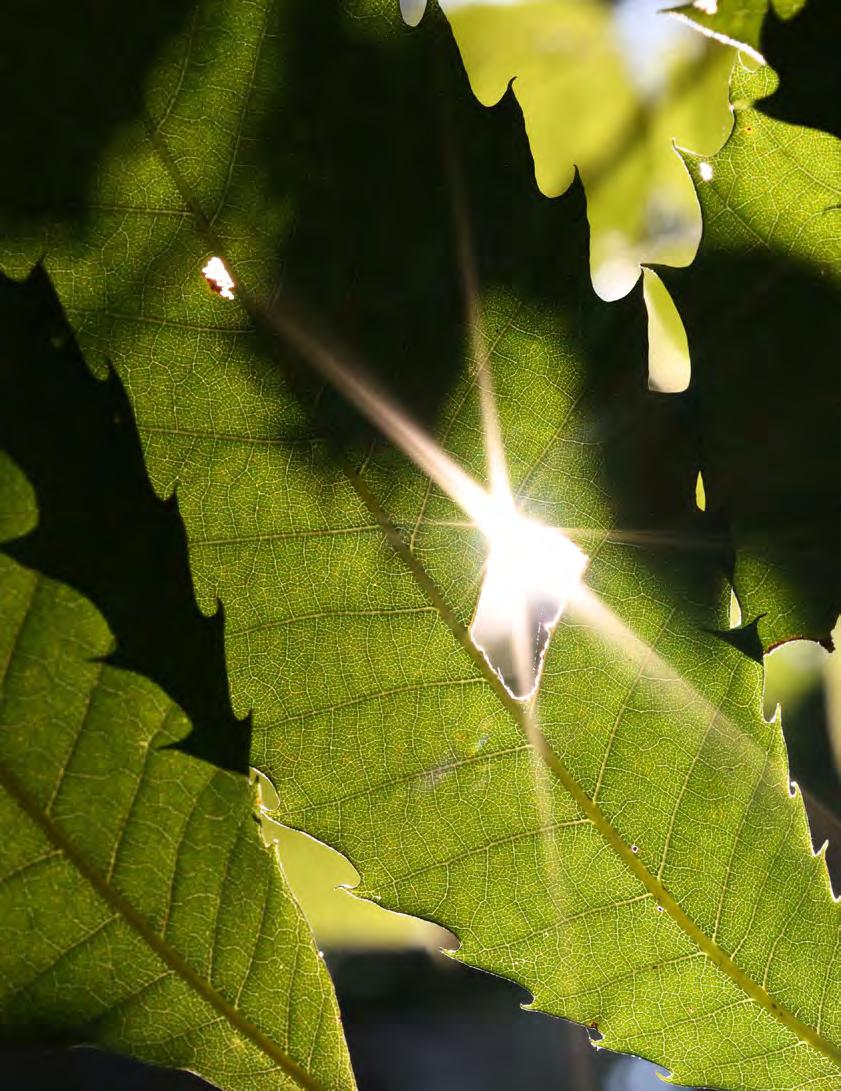
THE JOURNAL OF THE AMERICAN CHESTNUT FOUNDATION
SPRING 2024 ~ ISSUE 2 VOL. 38
Climate-Resilient
Trees ~ Musician GB Grayson ~ Best x Best Breeding Program ~ Chestnut Blight Fungus
A
TO MEMBERS
BENEFIT
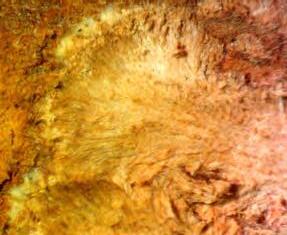
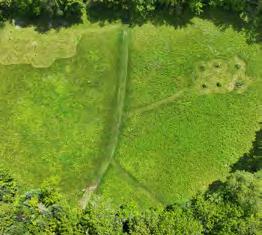
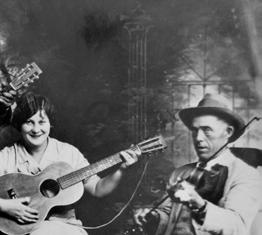
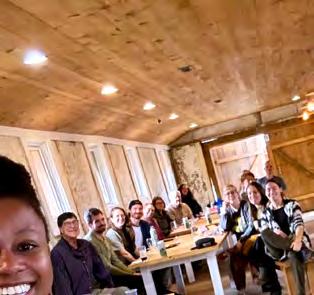

THE JOURNAL OF THE AMERICAN CHESTNUT FOUNDATION A BENEFIT TO MEMBERS Years as a: 9 36 INTERN REFLECTIONS Learning by Doing 38 RECIPE Chestnut Smoothie 27 SCIENCE Optimizing Disease Resistance The Chestnut Blight Fungus 39 TRIBUTE William Powell 40 IN HONOR AND IN MEMORY 17 HISTORY & CULTURE The Day the Music Died at Laurel Creek 1 PRESIDENT’S MESSAGE from Will Pitt 14 VOLUNTEER SPOTLIGHT Laura Podyma 3 NEWS Climate-Resilient Trees in Vermont The Tallest Chestnut Controlled Pollination in Central Virginia 22 A VIEW FROM MEADOWVIEW 24 RSC COLUMN Gearing Up for Best x Best 9 NEWS Two Maine Nonprofits, One Goal 40th Anniversary Celebrations SPRING 2024 ~ ISSUE 2 VOL. 38
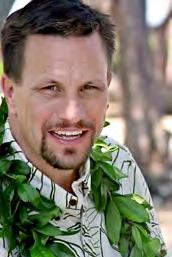 Will Pitt President & CEO
Will Pitt President & CEO
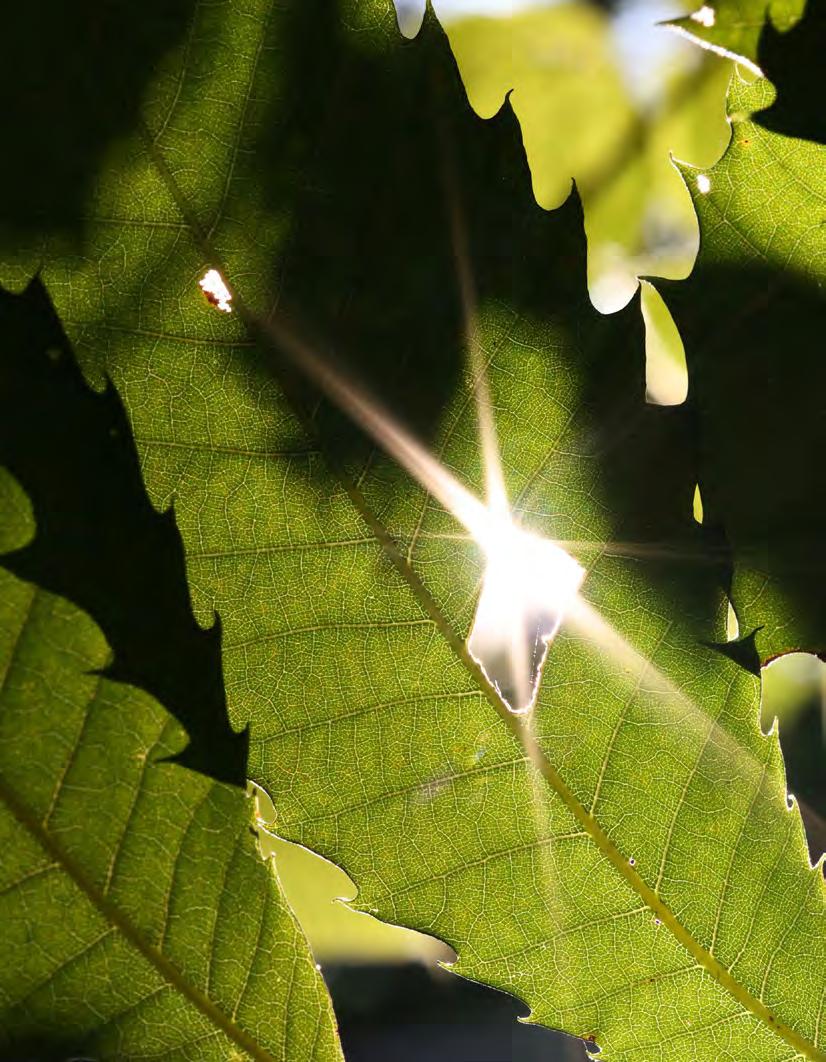
HELLO CHESTNUT ENTHUSIAST,
As the sun warms your face while you turn the soil in your garden, plant a chestnut seedling at a volunteer event, or simply step outside to admire the venerable force that is nature, I hope you will think of the ways in which the living world connects us all.
Another element that connects all of us is science. Scientific breakthroughs, progress, setbacks, and discoveries are all a part of our lives, especially when it comes to chestnut restoration. We move forward with strength and resolve, a cohesive unit focused on the same goal.
Speaking of goals, this year we have two comprehensive and forwardthinking projects in the works that will bridge science and nature, and your support of our 2024 Spring Appeal will bring them closer to fruition.
First, we would like to build a molecular lab at Meadowview Research Farms to expand our genetic capabilities. This lab will allow us to test the inheritance and location of the transgene, which will ultimately help us cut costs and speed up the efficiency of our restoration efforts.
Next, we are strengthening our best x best program and increasing the number of trees we are going to create through this breeding program. We will perform genotyping to predict blight resistance and select trees, which will eliminate the need to inoculate. Regional collaboration with our chapters will allow for diversity, and these steps, along with getting trees into the nursery pipeline, will allow us to get American chestnut trees to you, our members and supporters, more quickly.
To achieve this, we will need heavy equipment, along with funding for controlled pollinations and genotyping the trees. This will vastly improve TACF’s breeding program, so I invite you to help us move forward with these essential steps by making a gift today.
We have also called on the chestnut community to assist in our strategic planning. It is stakeholder involvement that will allow us to create the most effective and holistic plan possible, and I look forward to sharing our three-year plan with you in the future.
Nature is more than one plant and science has more than one path. Restoration goes beyond planting a single tree; it is building a bridge between science and nature, an integral part of ecosystems and communities alike. Thank you for helping us strengthen this connection.
 Will Pitt, President & CEO The American Chestnut Foundation
Will Pitt, President & CEO The American Chestnut Foundation
PRESIDENT’S MESSAGE The Journal of The American Chestnut Foundation ~ 1
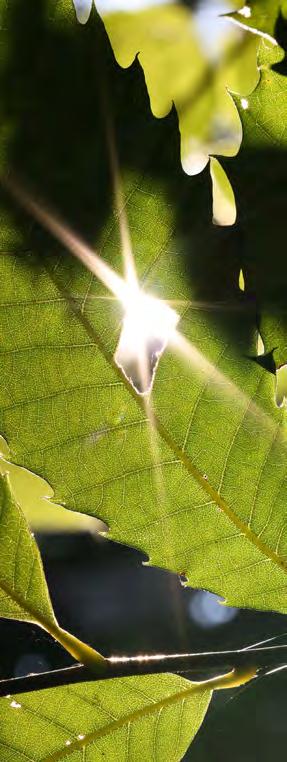
“Shining Hope”
TACF’s 2023 Photo Contest winner
Lily Zeporah came across this special tree in the heart of Virginia’s Blue Ridge Mountains. Lily said discovering a wild-type American chestnut felt “akin to discovering Black Beard’s treasure” and that “finding a young chestnut tree gives us shining hope for the future.”
WHAT WE DO
The mission of The American Chestnut Foundation is to return the iconic American chestnut to its native range.
CONTACT US: chestnuts@tacf.org • tacf.org facebook.com/americanchestnut • twitter.com/chestnut1904 • instagram/tacf1983
TACF National Office 50 N. Merrimon Avenue Suite 115 Asheville, NC 28804 (828) 281-0047
Meadowview Research Farms 29010 Hawthorne Drive Meadowview, VA 24361 (276) 696-9142
Mid-Atlantic Regional Office
Virginia Department of Forestry Central Office 900 Natural Resources Drive Charlottesville, VA 22903
New England Regional Office UVM Aiken Forestry Service Labs / USFS NRS 705 Spear Street South Burlington, VT 05403 (802) 999-8706
OFFICERS
CHAIR:
William J. (Jay) Cude, III, TN
VICE CHAIR AND GOVERNANCE COMMITTEE CHAIR: Rebecca (Becky) Carter, GA
PROMOTION AND OUTREACH COMMITTEE CHAIR: Betty McDonald Allison, NC
SECRETARY/TREASURER AND FINANCE COMMITTEE CHAIR: Barbara Tormoehlen, IN
SCIENCE AND TECHNOLOGY CHAIR: Deborah Delmer, Ph.D., NC
PRESIDENT & CEO: Will Pitt, Ph.D.
BOARD OF DIRECTORS
Martin Cipollini, Ph.D., GA
Mandy Adler Cromwell Ph.D., MA
Elizabeth Kramer, Ph.D., DC
Bruce Levine, MD, Chapters Committee Chair
Dennis Liu, Ph.D., NC
Lewis Lobdell, PA
Ambassador Catherine Novelli, VA, Government Relations Committee Chair
John Scrivani, Ph.D., VA, Restoration Committee Chair
Jim Searing, PA
Anna Sproul-Latimer, VA
ADVISORS TO THE BOARD
Brian McCarthy, Ph.D., OH, Immediate Past Chair
Charles G. Meyer, III, VA, Legal Counsel to the Board
Kim Steiner, Ph.D., PA, Science Advisor to the Board
EMERITUS MEMBERS
Essie Burnworth (d)
Gary P. Carver, Ph.D.
Hill Craddock, Ph.D.
Herbert F. Darling, Jr.
Michael Doochin
Hugh Irwin
William G. Lord, D.V.M. (d)
William L. MacDonald, Ph.D.
Rex Mann
Glen Rea
Kim Steiner, Ph.D.
Rufin Van Bossuyt
Richard Will (d)
Donald C. Willeke, Esq.
HONORARY DIRECTORS
Norman Borlaug, Ph.D. (d)
President Jimmy Carter
Richard A. Jaynes, Ph.D.
Mary Belle Price (d)
Peter H. Raven, Ph.D.
Philip A. Rutter
Edward O. Wilson, Ph.D. (d)
STAFF
ASHEVILLE
Will Pitt, Ph.D., President & CEO
Hal Brindley, Web Administrator
John Chastain, Director of Development
Lesley Heiser, Grants Manager
Shaomin Li, Controller
Angus Mullis-McCord, Development Analyst
Christine Oglesby, Operations Specialist
Jen Picicci, Communications Coordinator
Carrie Plaxco, Gifts and Records Specialist
Jules Smith, Director of Communications
North Central Regional Office
Pennsylvania State University 108 Business Services 206 Forest Resources Lab University Park, PA 16802 (814) 863-7192
Southern Regional Office 50 N. Merrimon Avenue Suite 115 Asheville, NC 28804 (828) 281-0047
Mark Weaver, Director of Business Operations
Jared Westbrook, Ph.D., Director of Science
Barbara Wood, Membership Coordinator
MEADOWVIEW
Vasiliy Lakoba, Ph.D., Director of Research
Dan Mckinnon, Director of Land Management
Lauren Kerwien, Lab Manager
Jim Tolton, Facilities and Grounds Technician
Lucinda Wigfield, Orchard Manager
Ciera Wilbur, Nursery Manager
REGIONAL STAFF
Sara Fitzsimmons, Chief Conservation Officer
Kendra Collins, Director of Regional Programs and New England Regional Science Coordinator
Lake Graboski, North Central Regional Science Coordinator
Hannah Leeper, Southern Regional Outreach Coordinator
Catherine Martini, Northern Regional Outreach Coordinator
Cassie Stark, Mid-Atlantic Regional Science Coordinator
Jamie Van Clief, Southern Regional Science Coordinator
EDITORIAL
Jules Smith, Editor
Lisa Alford, Design & Layout
Scott Carlberg, Contributing Author
2 ~ A Benefit to Members
EMBRACING THE PLANTING OF Climate -Resilient Trees in Vermont
By Tim Stout, VT/NH-TACF Chapter
Jockey Hill Farm sits in the middle of the Green Mountains of Vermont. It is 173 acres surrounded by more than 20,000 acres of the Calvin Coolidge State Forest and another 1,000 acres of preserved private land owned by other landowners. My family and I have owned the land for 82 years and have actively managed it for the last 47 years, with the goal of preserving it for future generations. We placed a conservation easement on it in 1993 and enrolled it in the State’s Use Value Appraisal Program in 1980. Under this program, we maintain a detailed land use plan with our consulting forester that defines our active management of the land, including periodic harvests.
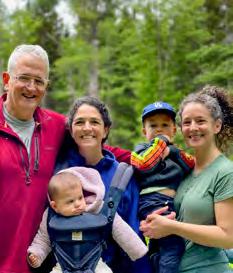
My entire family has been active participants in managing the land. While most of the land is forested, we have ten glorious fields that we all take turns mowing on an alternating basis each year for habitat reasons, hold an annual tree-planting event where we focus on planting climate-resilient trees, and offer frequent field trips and other events to fellow landowners and interested
parties around the state. In early 2020 my first grandchild, Abe, was born, followed shortly thereafter by his sister, Faye. The addition of Abe and Faye to our family has sparked a growing curiosity among family members as to how we can further manage the land for them and their generation. This has resulted in us embracing twelve land management strategies, such as enhancing the age and species diversity of our forest, accelerating the capacity of the forest to sequester and store more carbon, and striving to expand the biodiversity of the land, to name a few. A major focus has been on planting climate-resilient trees to explore tree species that currently are not found on the property but may thrive there in the future. We work closely with Dr. Anthony D’Amato, Director of the Forestry Program and of Research Forests at the University of Vermont and his colleagues to identify appropriate trees for this endeavor.
An exciting part of this project has been working with Kendra Collins, director of regional programs at The
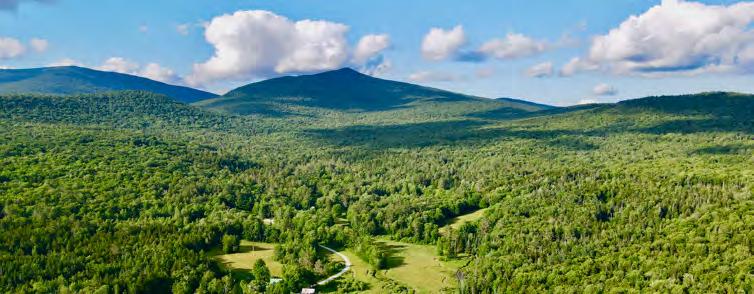 Jockey Hill Farm, surrounded by the Calvin Coolidge State Forest.
Jockey Hill Farm, surrounded by the Calvin Coolidge State Forest.
NEWS FROM TACF The Journal of The American Chestnut Foundation ~ 3
Tim with his daughters and grandchildren at Jockey Hill Farm.
American Chestnut Foundation (TACF), on planting 50 hybrid American chestnuts. These were planted in spring 2022. Despite our high elevation and less than favorable climate, as well as the threat of moose and deer browsing, the trees have been growing well. We have lost five to date, but most of the trees are healthy. We have planted nine other species of climate-resilient trees, but as a family, we are most excited about the American chestnut because of its history and the excitement of being part of TACF’s remarkable efforts to help the tree recover. We expect several existing species on the land to succumb to climate change over the coming years, and cherish the thought of chestnuts becoming another core tree species on our land. We appreciate that we will see many changes to our land in 50 years and are preparing now for those changes. While this endeavor has a strong practical side, it also has an important emotional side for me and my family. In 50 years, what will Abe and Faye experience at the farm? We feel privileged to have had the fun of being able to enjoy the land for so many years, and we love the thought of
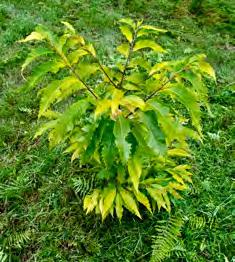
them driving to the farm to enjoy its beauty, despite changes that may have occurred over the previous fifty years. It is easy to become glum about the impending impacts of climate change, but recent well-established research has shown that there are many steps we, as landowners, can take to adapt to and mitigate climate change. We see chestnuts as a key element of this vision. As TACF has so clearly articulated over many years, chestnuts are vital for a multitude of reasons, perhaps most importantly, biodiversity. Among other benefits, the wildlife that depends on chestnut is inspiring, from insects to birds to other mammals.
While maintaining these trees is a lot of work, I can think of few endeavors that are more rewarding. Yes, it is for my generation, but also for future generations. Throughout New England and elsewhere, landowners play a critical role in preserving and enhancing our forests. Our passion for this work is reinforced almost daily through our close work with other landowners and by the dedication of TACF to bring back our beloved American chestnut tree.
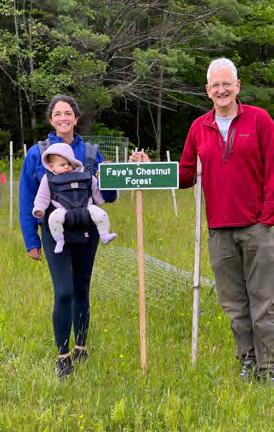

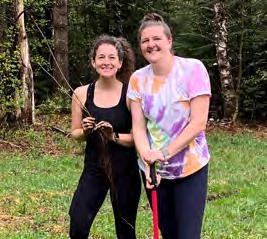
 One of 50 chestnuts planted in spring 2022.
Tim with his daughter Eliza and granddaughter Faye at Faye’s Chestnut Forest.
Family and friends at an annual tree planting weekend.
Tim’s daughter Alison and niece Emily planting climate-resilient trees.
One of 50 chestnuts planted in spring 2022.
Tim with his daughter Eliza and granddaughter Faye at Faye’s Chestnut Forest.
Family and friends at an annual tree planting weekend.
Tim’s daughter Alison and niece Emily planting climate-resilient trees.
NEWS FROM TACF 4 ~ tacf.org
Aerial photo of two tree plantings: one chestnut, and the other, red oak.

The Tallest Chestnut
IN AMERICA HAS EVIDENCE OF BLIGHT INFECTION
By Brian Roth, University of Maine and ME-TACF Chapter; David Allen, ME Forester and ME-TACF Chapter; Jan Ames Santerre, ME Forest Service; and coauthor, Kendra Collins, TACF Director of Regional Programs
Readers may recall an article in the 2016 winter issue of Chestnut magazine about the discovery of the tallest American chestnut in its native range near Lovell, Maine. The tree was documented at 115 feet tall and 16 inches in diameter and surpassed the State champion at the time, which was in nearby Hebron, Maine. Now, the Hebron tree is dead, and sadly, there are signs of blight in the crown of the Lovell tree. The tall tree in Lovell originated in an abandoned pasture sometime in the 1920s and fiercely competed with adjacent white pine trees for sunlight, leading to its tall, yet thin dimensions.
Discovery
In the summer of 2016, the ME Chapter embarked on a project to discover unknown large wild American chestnut trees in the state. With the assistance of graduate students at the University of Maine, a chestnut habitat suitability map was created using variables such as climate, and depth to water table, to predict areas with the highest probability of finding chestnut trees. In July, when the chestnut catkins were in full bloom, aerial reconnaissance missions were flown with a small airplane and an observer to photograph trees that appeared to be chestnut. The probable locations of these trees were geolocated within a few yards using triangulation and Google Earth imagery. These locations were later explored on the ground after obtaining landowner permissions in the fall to confirm the presence of chestnut. Fall is a good time to
discover chestnut, when some leaves and burs are on the ground. The tall chestnut in Lovell was found using this approach and has since attracted much attention to The American Chestnut Foundation (TACF) and large chestnut trees remaining in the wild.
Maine Register of Big Trees
Since 1968, the Maine Forest Service has maintained a list of the largest known specimens of native and naturalized trees in Maine. The 2020 Register lists the Hebron American chestnut, along with a yard specimen in Orono, as state co-champions, both of which are now deceased. The most likely candidate for the largest chestnut in Maine now is in Readfield in an area known as Factory Square. This tree stands at 82 feet tall and is 69 inches in circumference (photo with Jared Westbrook in 2017, pg. 6). New measurements will be taken to calculate the total points, which are
NEWS FROM TACF The Journal of The American Chestnut Foundation ~ 5
The American chestnut tree in Lovell, Maine in 2016.
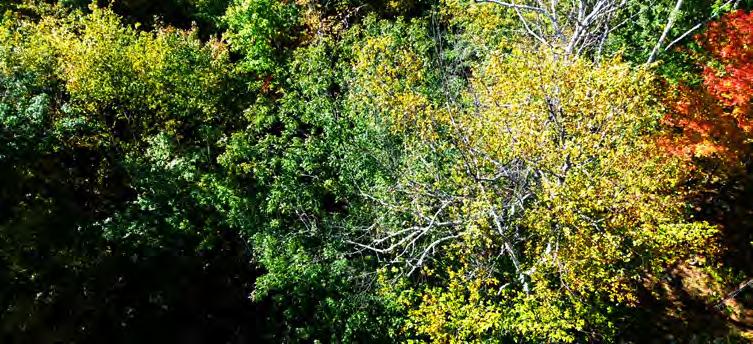
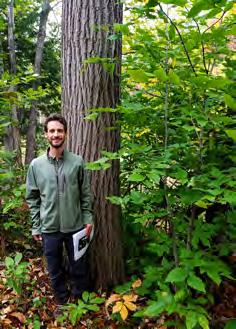
used to rank large trees in the register. To determine if a tree is a champion, the Maine Forest Service assigns each tree a score based on a formula that adds together the circumference in inches, height in feet, and ¼ of the crown spread in feet. The register is updated and published from time to time. The most recent Maine Register
of Big Trees can be accessed here: digitalmaine.com/for_docs/265/
Conservation
During a special visit to check the health of the Lovell, ME tree on October 14, 2023 by Maine Forest Service Ranger Michele Warner, it became obvious that the tree has significant dieback in the crown. Using a drone, Ranger Warner was able to examine the upper crown of the tree, which was very difficult to see from the ground, due to the tree’s extreme height and neighboring trees. The damage in the crown is very likely caused by chestnut blight. Once blight infects a wild tree like this, there is unfortunately little that can be done beyond observing disease progression and taking measures to preserve the unique germplasm while there is still time. Large, wild American chestnut trees such as this one were once common in Maine, with more than 500 documented in TACF’s dentataBase. However, over the years, these isolated trees have been dying from blight. Many of the wild trees are represented in the ME Chapter’s backcross breeding program, and their genes are conserved in
breeding orchards around the state, even if the founding parent has died. Other recent discoveries, including the Lovell tree, are captured in germplasm conservation orchards around Maine, ensuring a diverse range of locally adapted seed for breeding and restoration projects. To learn more about how TACF tracks wild American chestnuts, check out “Sampling, Identification, and Use of Wild American Chestnuts” in the Spring 2022 issue of Chestnut (tacf.org/chestnut-magazine) or visit tacf.org/identification.
Recovery
The tallest chestnut tree in Maine will likely succumb to blight within a few short years, as have so many other large chestnut trees over time. Discoveries of large chestnut trees are still being made by volunteers with TACF, and germplasm is being conserved in germplasm conservation orchards and in breeding programs. Restoration efforts by TACF ensure the genetic diversity of these large American chestnut trees, with the goal to return this iconic species to its native range.
Canopy view of the Lovell tree in 2023 showing significant dieback in the crown.
NEWS FROM TACF 6 ~ A Benefit to Members
TACF Director of Science Jared Westbrook standing in front of the Readfield tree in 2017.
A VOLUNTEER’S PERSPECTIVE: Controlled Pollination IN CENTRAL VIRGINIA
By Laura Podyma, VA-TACF Chapter
June to early July is chestnut pollination season in central Virginia. This is when the steady pace of activity accelerates for the VA Chapter.
Chapter President John Scrivani keeps a close watch on the trees to determine the pollination timeline, and sets the pace for pollinations in central Virginia. In 2023, controlled pollinations in central Virginia took place at Fortune’s Cove Nature Preserve, Lesesne State Forest, and Claytor Nature Center.
At these sites, third generation backcross trees, as well as wildtype American trees, were selected for pollination. Blight tolerance,
morphology, family line, genotypic data, tree form, and history of nut production are all taken into consideration when making selections for breeding. Key goals were to make best x best crosses and to increase the number of family lines for genetic diversity and regional adaptation. (See RSC Column on page 24 to learn more about best x best crosses.)
In May and early June, orchards were bush-hogged, mowed, and cleared of obstacles to facilitate access.
Prep work included cordoning off a massive underground yellowjacket colony at Lesesne. A prime “mother tree” candidate at Fortune’s Cove was disqualified by the presence of a large hornet nest in its sheltering branches. Heat, humidity, ladders, and bucket trucks mandate safety awareness in the pollination process. Multiple stings are a risk to be avoided, if possible.
For controlled pollination, timing is key. If flowers are bagged before the female flower’s white styles

NEWS FROM TACF The Journal of The American Chestnut Foundation ~ 7
Female flowers that were bagged and are now burs, ready to be harvested in 10-14 days.


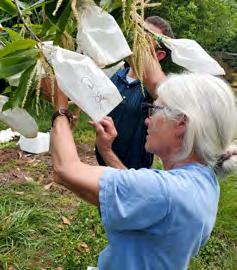
emerge, the flowers may abort. If they have developed to the “strawcolored” stage and are spreading apart, it is too late for bagging, as pollination may have already occurred (Figure 1). I studied photos of flowers and catkins at various stages of maturation and found it instructive to observe the mature Chinese chestnut tree in my yard. Its flowers developed a few weeks earlier than the trees we pollinated.
By June 6, Fortune’s Cove flowers were ready to be bagged. Secluded and picturesque, this Blue Ridge Mountains cove provided the perfect day for Cassie Stark, TACF regional science coordinator, to demonstrate her natural bucket truck maneuvering prowess. VA Chapter member Tom Wild took his maiden voyage in the bucket too. David Crouch, VA Department of Forestry, bagged from the orchard ladder, and I from the ground, thanks to a modified pole pruner. Flowers with styles protruding were isolated for bagging by snipping leaves and catkins within 6-8 inches, being careful to avoid snipping off flowers in the process. Each flower was gently bagged and secured. For every ten bags applied, one bag was marked
as a control, not to be pollinated. A total of 169 bags were placed that day.
The following day, I checked the status of the trees at Claytor Nature Center. One was ready for bagging; an offspring of a wild-type American growing near the Blue Ridge Parkway. This tree is still small enough to access from the ground. Small but productive, the tree had produced more than 500 nuts in 2022. I placed 66 bags on this tree and returned on June 19th to bag an adjacent tree; the offspring from a wild-type American tree in Shenandoah National Park.
By mid-June, more than 800 bags were placed in three central Virginia sites. Ten to 14 days is the optimal interval between bagging and pollination. During that interval, those closely packed white styles become straw-colored (Figure 1). The flower that eventually becomes the bur also swells. The female flower is now receptive and ready for pollination.
Meanwhile, stormy weather raged through the orchards. Some bags became waterlogged and others blew away. Pollination in some cases had to be delayed, stretching the limits of optimal timing.
By June 20, trees at Fortune’s Cove were ready to pollinate. John and David completed the bulk of that pollination, while I kept track on the reporting form. TACF Board member Anna SproulLatimer and I received instruction in the bucket truck, finishing up just before the storms set in.
On June 23, the weather calmed in Bedford. Cassie traveled to Claytor Nature Center, bearing a cooler containing pollen that was gathered from a large surviving American chestnut tree at Lesesne State Forest. Joining us was chestnut enthusiast and volunteer Jared Quesenberry. Cassie instructed us in careful removal of each bag to brush the now receptive styles across a glass slide containing pollen. Bags were immediately resecured after pollen application. By June 30 most of the Lesesne pollinations had been completed. One tree remained to be pollinated in the American orchard. I was grateful to be recruited to assist. It was an especially good feeling to stand under the two largest surviving American trees at Lesesne, “Thompson” and “Ragged Mountain.”
Laura is the recipient of this issue’s Volunteer Spotlight feature. Read more about her and how she became interested in restoring the American chestnut on page 14.
Laura places a bag over freshly pollinated flowers at Lesesne State Forest in Virginia.
FIGURE 1. (Left) Styles tightly packed and just beginning to emerge, this flower is ready to be bagged. (Right) Styles have turned straw colored and spread, this flower is likely receptive and ready to pollinate (too late to bag).
Emerging styles
NEWS FROM TACF 8 ~ tacf.org
Straw colored styles, ready to pollinate
Two Maine Nonprofits, One Goal
By Jenn Hicks, Director of Communications and Outreach at Maine Woodland Owners, and Mark McCollough, ME-TACF Chapter President
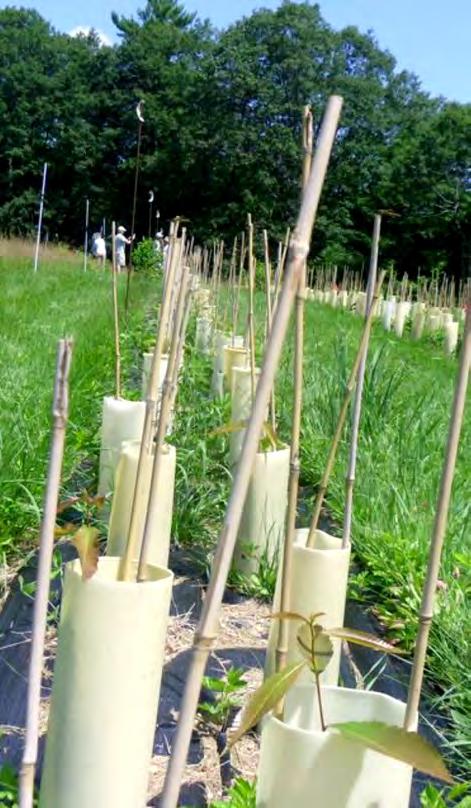
When the ME Chapter sought to establish the first backcross breeding orchard in New England, challenges were abundant. First and foremost was finding a suitable space for the project. Though partnerships among a vibrant conservation community have been an essential part of the ME Chapter’s work to restore the American chestnut, nothing like this had existed before.
There was a lot of love for American chestnuts among our land trust friends and interested landowners, and they were quick to offer places among their holdings to serve as orchard locations. However, few had several acres of protected open space with well-drained soils suitable to grow chestnuts.
In fact, ninety percent of The Pine Tree State is covered in a verdant blanket of spruce, fir, white pine, and red oak, and farms are sparse in this rocky, hardscrabble country. Forest products, along with tourism and fishing (lobster), are the basis of Maine’s economy, and trees cut for pulpwood, firewood, or sawlogs are immediately replaced by fast-growing saplings. An eagle flying overhead sees a sea of forest punctuated by lakes, rivers, and peatlands – not many gaps for a chestnut orchard.
The Chapter’s network led to a partnership opportunity with the Small Woodlot Owners of Maine (now Maine Woodland Owners), an organization that promotes the stewardship of Maine’s small woodland resources. With a membership of a few thousand, Maine Woodland Owners works to strengthen long-term woodland ownership, improve forest quality and health, protect waters and wildlife habitats, and demonstrate forest management through its Land Trust. At the time of our land search, the organization managed just under 4,000 acres of forest (they now have more than 11,000 in fee and easement throughout the state). Among their ownerships was a 175-acre woodlot in the coastal town of Searsport, donated by Bruce and Joan Probert. The lot’s 5-acre field would eventually become one of the ME Chapter’s seed orchards. Bruce, who was a forester trained at the University of Maine, lovingly stewarded the young orchard and “his” chestnut trees and regaled visiting “chestnutters” with stories of hunting and fishing in the North Maine Woods.
A newly planted American chestnut seed orchard on Maine Woodland Owners Land Trust property in Searsport, Maine.
NEWS FROM TACF The Journal of The American Chestnut Foundation ~ 9
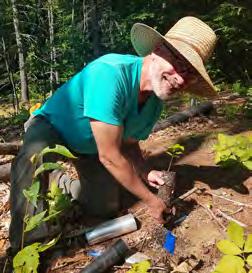
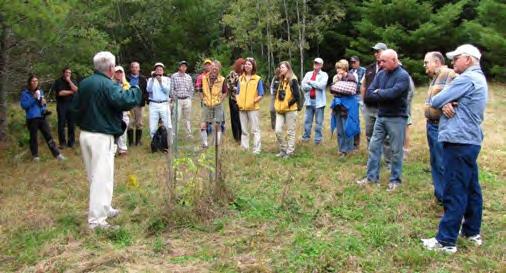

Today, the ME Chapter manages 10 breeding orchards, six seed orchards, and 11 GCOs with conservation partners. In addition to Searsport, chestnut trees are also growing on Maine Woodland Owners’ land in Winthrop, a small town just outside of the State’s capital, Augusta. The oldest trees at the Searsport seed orchard were planted in 2012, where there are 30 blocks of Clapper lines. The Winthrop orchard, also developed in 2012, has 19 blocks of Graves lines. We began inoculating these trees in 2018 and continue thinning and inoculating them. The oldest blocks of 150 trees have been thinned to five to 10 “best” trees that show some blight resistance.
“The opportunities that have been granted to us through this exciting partnership are innumerable. We have been grateful that we get to play a role in this very important research and conservation effort,” said Tom Doak, Maine Woodland Owners executive director.
Beyond the obvious benefits of partnering to maintain a living laboratory, the two organizations work together to develop and lead educational events at the chestnut orchards. Maine Woodland Owners and the ME Chapter share members. Many who are not ME Chapter members are very curious about ways to help restore this iconic species. Maine Woodland Owners and its members are an essential component in restoring the American chestnut, and beyond the seed orchards, the hope is to collaborate on silviculture trials and germplasm conservation efforts as we prepare for the return of the tree.
Maine Woodland Owners has been one of ME Chapter’s steadfast supporters, and many more collaborations, such as educational plantings and restoration trials, are expected in the future.
Maine Woodland Owners and the ME Chapter of TACF have hosted many public tours of the American chestnut orchards. Glen Rea, past president of the ME Chapter, leads a tour at John Sferazo’s chestnut orchard in Concord Township, Maine.
Maine Woodland Owners volunteer Kevin Kane at the Winthrop seed orchard in 2012. These trees are now 25 feet tall.
NEWS FROM TACF 10 ~ A Benefit to Members
The 2012 agreement letter signed by then ME Chapter President Glen Rea that launched the partnership with Small Woodland Owners Association of Maine (now Maine Woodland Owners).
40 TH ANNIVERSARY CELEBRATIONS
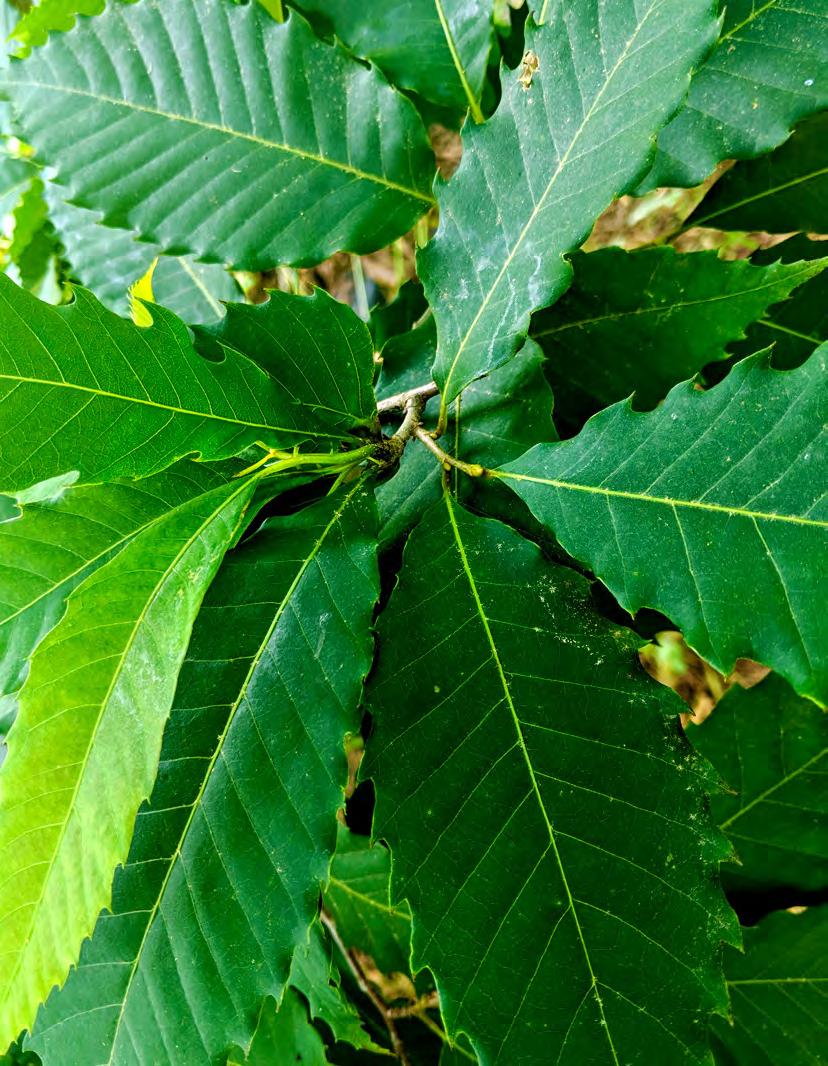
As 2023 came to an end and we transitioned into a new year, state chapters continued to celebrate The American Chestnut Foundation’s (TACF) 40th anniversary. Spirits are still high throughout all four regions as festivities across the tree’s native range begin to wind down. From breweries to libraries, the American chestnut story has been shared and commemorated.
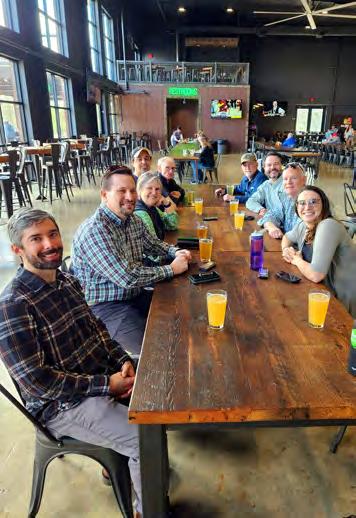
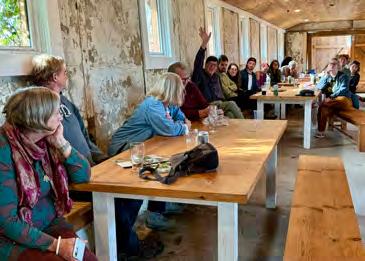
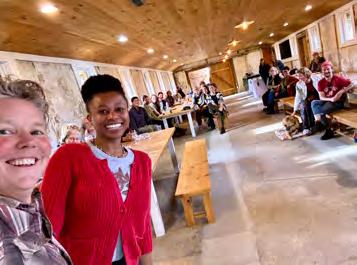
HT E A MERICAN CHE STNUTFOUNDA T I O N 1983 – 2023 4Oth ANNIVERSARY
AL Chapter 40th Celebration at the Back Forty Brewery in Birmingham, AL.
Carolinas Chapter 40th Celebration at Fonta Flora Brewery in Nebo, NC.
NEWS FROM TACF The Journal of The American Chestnut Foundation ~ 11
4Oth
ANNIVERSARY
1983 – 2023
TACF is grateful for its chapters and their participation in this crucial research over the last four decades. Their willingness to spread the word and involve local volunteers and members is also valued. Even though we have focused most recently on celebrating the past 40 years of TACF, it is equally exciting to look toward the future as we continue to grow and make substantial progress in our collective restoration mission!
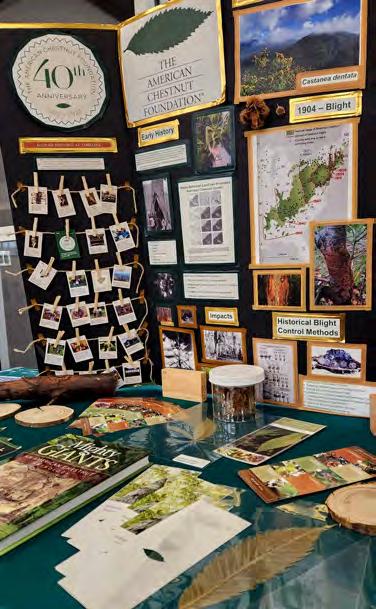
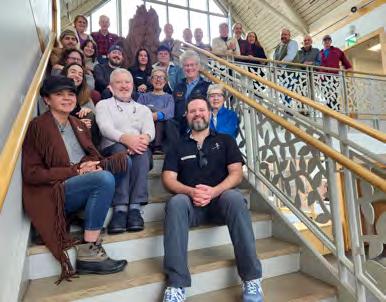
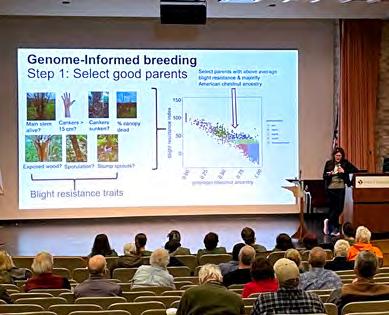
T I O
HT E A MERICAN CHE STNUTFOUNDA
N
AL Chapter’s 40th Celebration display table.
TN Chapter 40th Celebration at Cheekwood Estates in Nashville, TN.
NEWS FROM TACF 12 ~ tacf.org
Chief Conservation Officer Sara Fitzsimmons presenting at the MA/RI Chapter’s Chestnut Symposium for their 40th Celebration at Smith College.
April 21-27, 2024
Thank you for your brilliance, dedication, and hard work.
This year, from April 21 to April 27, our country observed National Volunteer Week. At The American Chestnut Foundation (TACF), we deeply appreciate the thousands of volunteers whose labor of love leads to joyful collaboration with us.
Because of you, TACF continues to thrive. Your help allows us to preserve the genetic diversity of the American chestnut tree, advance our breeding program, and work toward creating a new approach to species restoration. Each of you bolsters this grassroots movement that spans 21 states.
This past year, volunteer chapter meetings celebrated wonderful milestones. In Alabama, new President & CEO Will Pitt met with volunteers focused on expanding and growing this budding Chapter. The Carolinas Chapter convened at Fonta Flora Brewery in Nebo, NC, where delicious chestnut beer was on tap, and a screening of CLEAR DAY THUNDER: Rescuing the American Chestnut warmed hearts.
For those who have not yet experienced the rewards of chapter membership at TACF, please visit support.tacf.org/membership for everything you need to know.
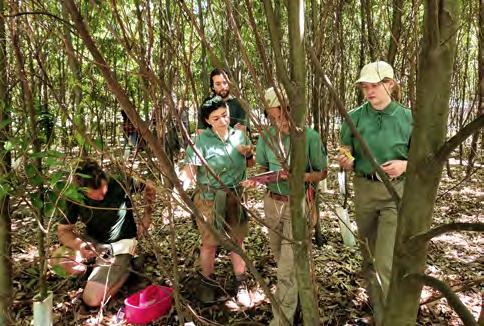
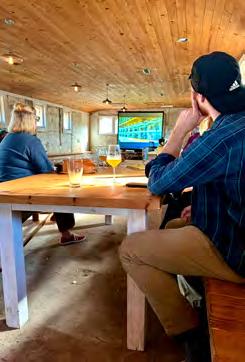
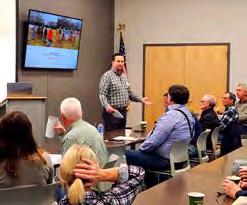

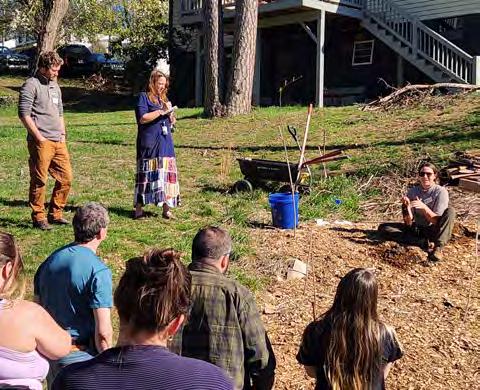
NATIONAL VOLUNTEER WEEK
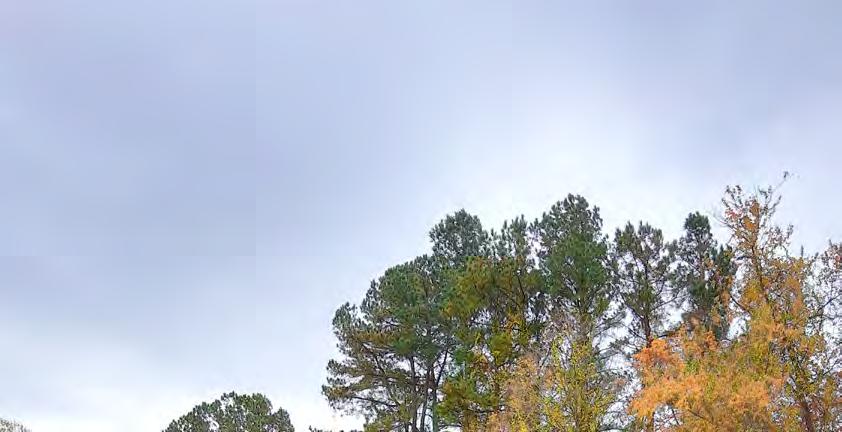
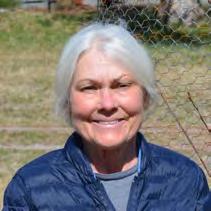
Laura Podyma
VA CHAPTER VOLUNTEER ADDS NURTURE TO NATURE
By Scott Carlberg, Contributing Author
Working with children and with chestnuts both require patience, if you ask Laura Podyma, volunteer with the VA Chapter of The American Chestnut Foundation (TACF). Every child and every tree has potential. Nurturing them takes collective and sustained efforts.
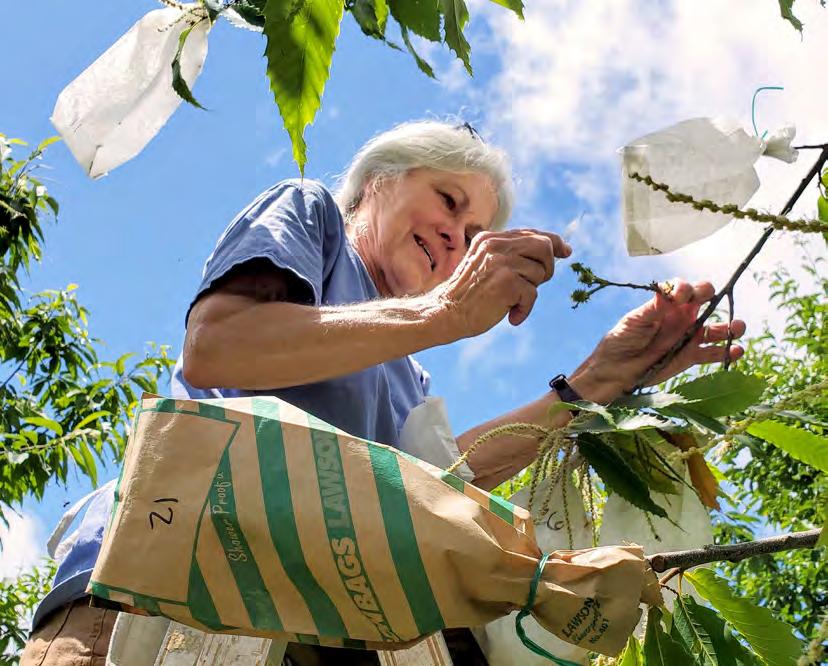
14 ~ A Benefit to Members VOLUNTEER SPOTLIGHT VIRGINIA CHAPTER
Laura became a volunteer at TACF in 2020, but she prepared for decades before that, especially as a physical therapist assistant (PTA). “My role as the assistant was to carry out the plans of care designed by the PT. It was my responsibility to provide handson treatment, observe the patient’s response, and provide feedback to the evaluating physical therapist.”
“A PTA has to be attentive, observant, watchful for changes, and manage working with a multitude of variables.”
Chestnuts and children: “When working with a child you strive to nurture their health, strength, and growth in a positive direction. Same with a tree. All are precious, essential to the future, and require us to access our heart. These efforts are
humbling. You do your best with the knowledge and resources at hand and hope for success.”
Laura has always been busy, even as a youngster. “I loved being outdoors. A garden of tomatoes, peppers, and mint in the backyard. Big paper route. Summer camp in the mountains. I was a worker.”
“As a young girl I spent as much time as possible playing in the woods near my home. I was a Girl Scout. Walking home from Scout meetings I always took the shortcut through the woods.”
Those years were in the Piedmont. “Growing up in North Carolina I was aware of the chestnut decline. I saw the fallen chestnuts in the mountains.” That stayed in the back of her mind.
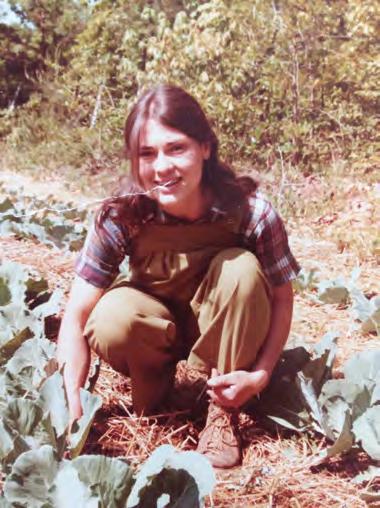
A series of career choices led Laura to become a devoted volunteer at TACF.
Finding long-dead remains of American chestnuts in North Carolina was her catalyst to enroll in the preforestry program at Appalachian State University. Laura furthered her knowledge of silviculture working on a Christmas tree and sheep farm in the mountains of Ashe County, NC.
A move to Bedford, Virginia meant a new job with a nonprofit, bringing together youth from different cultures: Israeli, Palestinian, Nigerian, Lebanese, and American teens eating at the same table, swimming in the same pool, and picking tomatoes in the garden together.
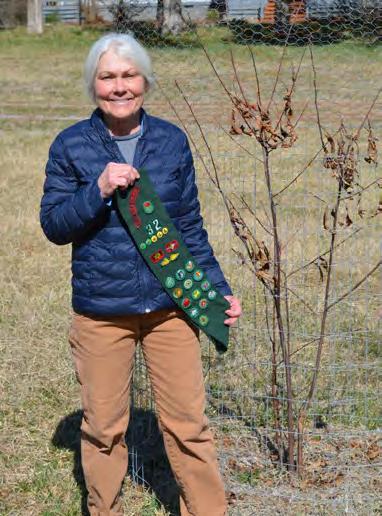
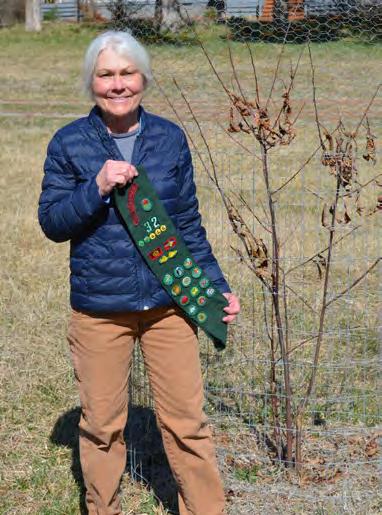 Laura with her Girl Scout sash today. Those skills transferred well to caring for chestnuts.
Laura with her Girl Scout sash today. Those skills transferred well to caring for chestnuts.
The Journal of The American Chestnut Foundation ~ 15 VOLUNTEER SPOTLIGHT
Laura working the garden in the 1970s.
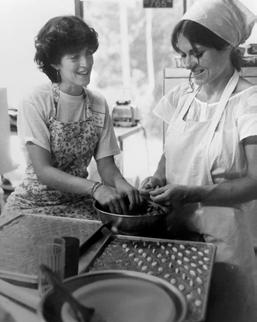
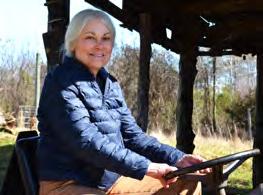
Later, Laura became a physical therapist assistant, working for ten years in pediatrics. After nearly three decades in PT, “I am very comfortable working under the direction of experts. I understand a plan may take an unexpected turn once it is being implemented, and results may not always be those that were initially expected.”
Her work in physical therapy instilled patience. “In the practice of physical therapy,” Laura says, “results are never instant. Time, consistent effort, and revisions to plans are critical components to achieving desired developmental and recovery goals.”
Sounds a lot like chestnut research. “The time component in chestnut work stretches far beyond a single
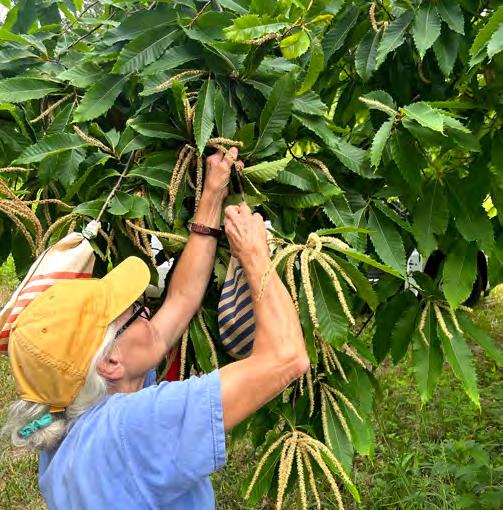
person’s lifespan. Consistent effort and plan revisions across succeeding generations of scientists and enthusiasts like me will be necessary to achieve the desired recovery goals,” says Laura.
Laura currently is assisting in a forest progeny test on Johns Creek Mountain in Craig County, Virginia. “We are collecting data on blight resistance and forest competitiveness of 1,080 B3 F3 seedlings planted in 2012. We completed one unit in winter 2023 and are working now on a second unit, not fenced or protected in any way.” This is near Blacksburg, Virginia. Closer to home, “I represent the VA Chapter to collaborate with the Bedford Master Gardeners (Virginia Cooperative Extension) to
establish a demonstration planting of chestnuts in Falling Creek Park. The intent of this planting is to educate the community and spark interest in chestnut restoration.”
John Scrivani, VA Chapter president, recognizes how Laura’s diverse background developed into an avid chestnut volunteer: “She brings curiosity and enthusiasm, but also attention to detail and critical thinking; all key in citizen science work. She is not afraid of getting her hands dirty and sometimes enduring tedious tasks.”
That kind of attention is easy for Laura because she sees trees and children with the same frame of mind: “With every seedling you think, this could be one that really thrives.”
Laura (right) works in a kitchen alongside a Lebanese exchange student in the early 80s.
Laura pollinating a tree: “The time component in chestnut work stretches beyond a person’s lifespan.”
16 ~ tacf.org VOLUNTEER SPOTLIGHT
Laura’s varied background allows her to tackle any chore – even on a tractor.
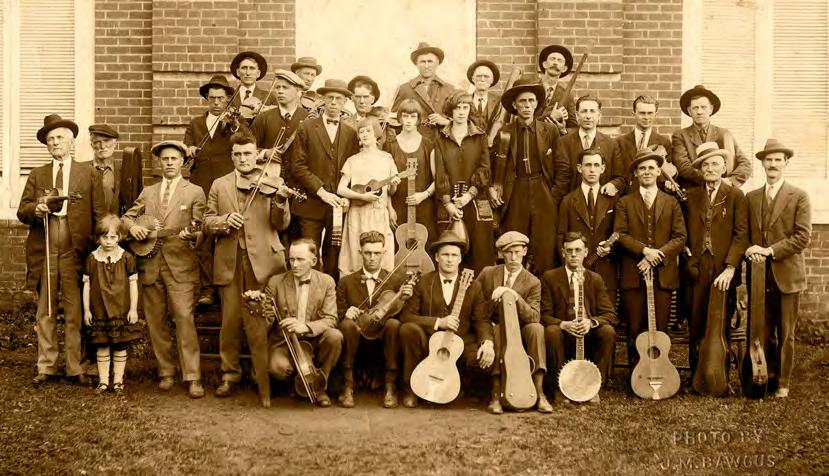
1925 Mountain City Fiddlers with GB Grayson (third row, far left).
Photo courtesy of Marshall Wyatt. A key that identifies everyone can be found here: tinyurl.com/bd52658y.
The Day the Music Died at Laurel Creek
AND THE ROLE THAT CHESTNUT BLIGHT PLAYED
By John Hempel, TACF Science and Technology Committee
In addition to the economic impact on the Appalachian people caused by the loss of Castanea dentata, at least one fatality can be attributed to the blight as well.
I returned from the October 2004 opening of the Ralph Stanley Museum in Clintwood, VA, north of Abingdon, with The Recordings of Grayson & Whitter . 1 Many of the tracks quickly became favorites, but a reference to chestnut blight in the liner notes was unexpected.
Gilliam Banmon (GB) Grayson is generally referred to as a blind fiddler,(Footnote A) yet by one account
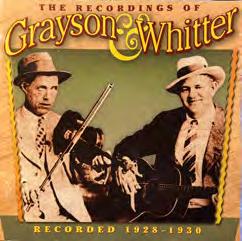
during a chestnut harvesting party, he gathered as many nuts as anyone else, so “severely visuallyimpaired” may be more accurate.
Born in 1887 in or near tiny Laurel Bloomery, TN,(Footnote B) he lived his entire life there, losing both parents by age 15. His disability allowed him to receive his father’s (Union) Civil War pension, which he supplemented by working as an itinerant musician, primarily playing banjo or fiddle. He performed and may have taken the top prize (accounts differ) at the legendary May 1925 Mountain City (TN) Fiddlers Convention.(Footnote C) Henry Whitter, whose famed “Wreck of Old 97” had been recorded in 1923 on the OKeh label by Ralph Peer, had become an influential scout by 1927, attending that year’s
The Journal of The American Chestnut Foundation ~ 17 HISTORY & CULTURE

Bridging Science and Nature:
INNOVATIONS ACCELERATED THROUGH YOUR SUPPORT
Just as the work of The American Chestnut Foundation is driven by the intersection and coordination of grassroots volunteerism, academic partnerships, and boots-on-the-ground implementation, so too are the science and decisions that unite those activities. TACF staff are optimizing modern molecular and modeling methods to ensure the most disease-resistant and ecologically sound American chestnut trees are selected for long-term service to our forests.
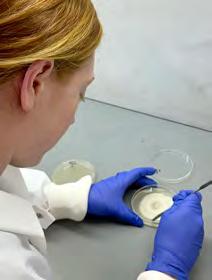
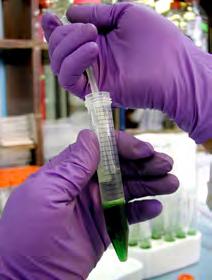
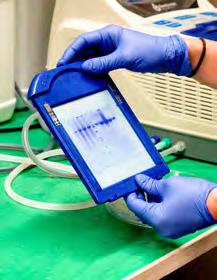
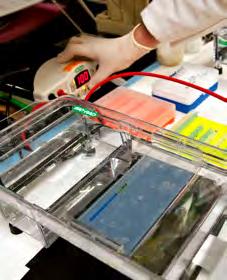
To fully execute this vision, we must develop essential in-house laboratory capabilities, such as:
• performing first-hand confirmation and evaluation of molecular constructs, especially in the newest transgenic lines,
• refining germplasm conservation priorities and tracing wild American chestnut ancestries,
• independently verifying gene and protein expression in all improved disease-resistant varieties, and
• basing expectations of tree performance on first-hand phenotypic and genotypic data.
Through your donations, these functions will strengthen TACF’s scientific collaborations, ability to monitor parallel efforts, and our leadership in restoring the iconic American chestnut tree.
Using the best-performing trees in our orchards, staff and other collaborators are creating populations of American chestnuts with enhanced disease resistance. For ongoing genetic gain and improvement, those trees are and will be tested in the field and the lab.
Our appeal this spring creates the vital bridge between these programs, building seamless connectivity that will deliver American chestnut seeds and seedlings to you for planting in the next two to five years.
2024 SPRING APPEAL
GB Grayson (far right) with Henry Whitter, along with the Greer Sisters, about which little is known (even their names!) other than they may have been from Wautaga County, NC (South of Mountain City, TN) and once played in a radio broadcast from Emory, VA with Tom Ashley, who frequently performed with GB on banjo.
courtesy of Josh Beckworth.
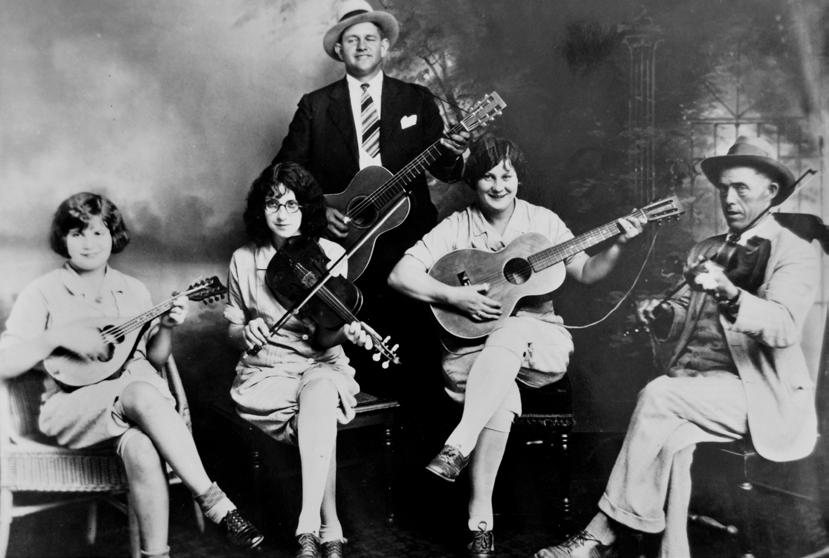
Convention to look for a partner to boost his flagging recording career. He found that partner there in GB.
Soon thereafter, Peer, now with the Victor label, was nearby, holding his famed Bristol Sessions(Footnote B) from which The Carter Family and Jimmie Rodgers emerged. Henry recorded two sides there, too, but likely attended mainly to contact Peer. Soon, he and GB were in Peer’s offices in New York, starting their memorable and influential partnership. Then, in just two years of recording together for Gennett and Victor at sessions in New York, Memphis, and Atlanta, Grayson & Whitter recorded 41 sides with sales approaching 100,000, earning Grayson enough to buy a house by 1930.2 However, being blind, he still had to rely on others for rides or just walk.
On August 16, 1930, GB’s pre-arranged ride home from Damascus, VA(Footnote B) to Laurel Bloomery never showed, so he accepted a ride on the running
board of neighbor Curtis Millhorn’s 1929 Pontiac coupe. Millhorn began driving erratically and soon collided near the end of the bridge over Laurel Creek with a truck hauling “chestnut extract,”(Footnote D) driven by Ferd Gentry, another neighbor. GB went through the truck’s windshield and out the doorless passenger side, into the creek. By the time he reached the hospital in Abingdon, he was gone at age 42. Without the blight, there would have been no salvage industry or truck loaded with extract.
Henry Whitter continued to perform occasionally but GB’s death effectively ended his recording career. A trip to New York with banjo player Fred Miller, who had recorded (Columbia) with Frank Blevins & His Tarheel Rattlers, had been planned for the week after the accident.2 We can only wonder what further music Grayson, Whitter, and Miller might have produced, but for chestnut blight.
GB Grayson’s Musical Legacy
If Bill Monroe is the father of bluegrass music, then GB Grayson is a grandfather. Artists who have covered Grayson & Whitter’s recordings include Mick Jagger and Bob Dylan (“Handsome Molly”), The Country Gentlemen (‘’Handsome Molly,” “Train 45”), Ralph Stanley (an entire CD, “Short Life of Trouble”), and The Kingston Trio (“Tom Dooley”). At the end of the latter, the line, “…hadn’t ‘a been for Grayson I’d be in Tennessee,” refers to his uncle, (Union) Maj James Grayson, who was part of the posse that tracked down the actual Tom Dooley (Dula).
More recently, The Dry Branch Fire Squad covered “He is Coming to Us Dead” (Atlanta, October 1927). The 1899 song, written by prolific black songwriter Gussie Davis, involves a Spanish-American War soldier’s body arriving home by train. It is surely one of the earliest recorded anti-war songs. Rather than an overt protest like the Peerless Quartet’s
20 ~ A Benefit to Members HISTORY & CULTURE
Photo
1914 “I Didn’t Raise My Boy to be a Soldier,” generally credited as first of the genre, this song is more in the vein of John Prine’s “Sam Stone” – the protest comes from the story it tells.
For many at TACF, “Going Down the Lee Highway” (Memphis, September 1929), should resonate. The Lee Highway runs through Abingdon and
FOOTNOTES
Meadowview as Route 11 in its leg from New Market, VA to Chattanooga, TN. Said to have been written while rolling down Route 11 in Whitter’s car, likely a 1926 Studebaker,(Footnote D) it is a fine example of GB’s fiddling.
Grayson & Whitter are easily found on YouTube and still heard on the radio, too. Near Meadowview, on Emory &
A From staring at snow on a very sunny day at a young age.
B Bristol, Damascus, Laurel Bloomery, and Mountain City are all within 30 miles of TACF’s Meadowview Research Farms.
C Musical historians have called the 1925 Convention the Woodstock of early country music.
D The late Bill Lord, TACF board emeritus, explored Champion Paper Mill, (Canton, NC) and the chestnut salvage industry that emerged in the wake of the fungus, in the 2004 issue of The Journal of The American Chestnut Foundation; reprinted in Mighty Giants: An American Chestnut Anthology 3
E The CD liner notes refer to a Model T Ford.1 In Always Been a Rambler2 a 1922 photo shows Whitter behind the wheel of an earlier Model T, but in another he is seen with what is described as a new Model A Ford; actually, a 1926 Studebaker. Whitter’s wife, however, is separately pictured in front of a 1928/9 Model A.
SOURCES
Henry College’s WEHC, Ivy Sheppard often plays their recordings on her Born in the Mountain program. Further, an excellent documentary, Short Life of Trouble, and an extensively researched biography, Always Been a Rambler have recently been released.2,4 Rather than fading into obscurity, Grayson & Whitter seem to endure.
1 Wilson, Joe (1998) Liner notes in: The Recordings of Grayson and Whitter, Recorded 1928-1930. Charlottesville, VA: County Records CD 3517.
2 Beckworth, Josh (2018) Always Been a Rambler. Jefferson, NC: McFarland.
3 Lord, Bill (2007) In Mighty Giants: An American Chestnut Anthology, Chris Bolgiano & Glenn Novak, eds Bennington: The American Chestnut Foundation pp 72-4.
4 St Germain, Kelly (2022) Short Life of Trouble. Vimeo: shortlifeoftrouble.com. Use of CD cover has been secured via Rebel Records successor: downhomemusic.com/product/the-recordings-of-grayson-whitter-1928-1930.
DEDICATION
This article is dedicated to my old friend Bill Lord: Battle of the Bulge veteran, Blue Ridge Parkway ranger, veterinarian, author, and consummate historian of the American chestnut, with eleven pieces in Mighty Giants: An American Chestnut Anthology
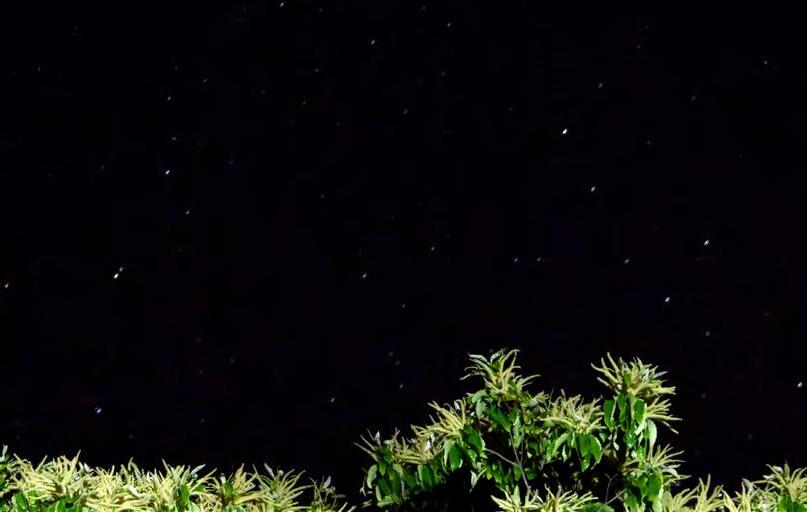
2024 American Chestnut Photo Contest
We want to see your colorful, creative, and unique photos of American chestnut or hybrids. A funny photo of a squirrel stealing a bur? Perfect. Winter’s final snow clinging to dry chestnut leaves? Terrific. Catkins in silhouette against a sunset? Excellent. We love to see every season, angle, and aspect of American chestnut, leaving us oohing and ahhing over your photos!
• be submitted digitally via email or a link to a cloud drive by September 1, 2024;
• relate to the American chestnut;
• be at least 2400 x 3000 pixels (7.6 MBs) and submitted in a jpeg or tiff file format;
• include the name of the photographer and their contact information;
EMAIL ADDRESS FOR SUBMISSIONS: communications@tacf.org LACE UP THOSE HIKING BOOTS AND GET CREATIVE!
• include a full caption containing names of subject(s), location, and title;
• be limited to a total of five photos;
• be previously unpublished and cannot be entered into another contest.
The winner will receive a one-year membership to TACF and the winning photo will be published on a future cover of Chestnut. Second- and third-place winners are also recognized and on occasion, a runner-up will be selected.
INFORMATION AT: tacf.org/2024-photo-contest
ALL ENTIRES MUST:
HISTORY & CULTURE
PHOTO CREDIT: 2019 3rd Place Winner “Chestnut Night” taken in Quakake, PA by Jim Schuetrumpf.
MORE


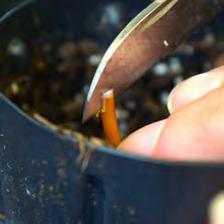
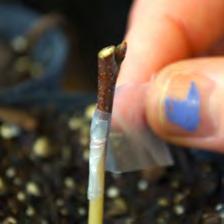
MEADOWVIEW 22 ~ tacf.org

MEADOWVIEW
A View FROM
Conserving American chestnut genetic diversity is critical for restoring the species. Only highly diverse restoration populations stand a chance against future diseases and climate change by providing fertile ground for natural selection. TACF has been collecting American chestnut germplasm for four decades and continues to do so through seed, pollen, and vegetative propagation. Vegetative propagation includes grafting, rooting cuttings, stooling, and other methods that allow one tree to become multiple trees without sexually crossing with another, thus passing on identical genetics.
Compared to apples, tomatoes, or ginkgo, which are fairly easy to graft, chestnuts require more care and patience. In late winter, Meadowview Research Farms staff began a grafting experiment (opposite page) focused on aftercare, to isolate treatments that help fragile new unions survive their first growing season and transition to orchard life.
In the meantime, successful chestnut and chinquapin grafts completed by collaborators with the U.S. Forest Service have broken bud in the greenhouse at Meadowview and await orchard planting after an early start on the growing season (this page).
MEADOWVIEW The Journal of The American Chestnut Foundation ~ 23
Gearing Up for Best x Best:
TACF’S REGIONAL TEAM PREPARES TO SUPPORT THE EVOLUTION OF CHAPTER BREEDING PROGRAMS
By Kendra Collins, TACF Director of Regional Programs
What Is Best x Best?
The science-based approach of The American Chestnut Foundation (TACF) began with the hypothesis that a backcross breeding program, assuming a small number of blight-resistant genes, could produce a diverse population of American chestnut trees with enough disease tolerance to be restored to Eastern forests. Over the past 40 years of
working towards this restoration goal, we have learned a lot about the complexities of blight resistance and have made adjustments to our range-wide breeding program to keep aiming for success. Carried out at our Meadowview Research Farms, and in most of our state chapters, the breeding program is quite large, encompassing approximately 500 unique wild American chestnut parents,
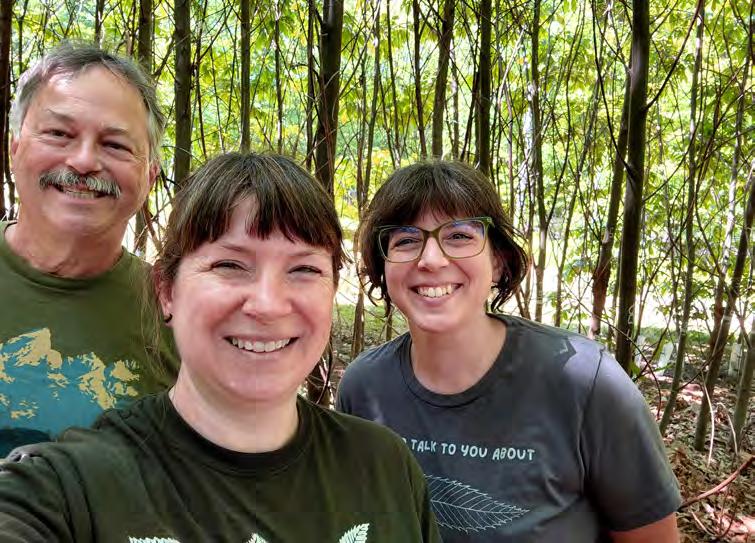
24 ~ A Benefit to Members RSC COLUMN
Jack Swatt (CT Chapter President), Kendra Collins (Director of Regional Programs), and Catherine Martini (Northern Regional Outreach Coordinator), as well as a crew of local volunteers, work to screen trees in a CT seed orchard to begin determining their breeding potential.
and occupying hundreds of orchards. Shifting the approach to this breeding work to utilize the best information we have has been no small task and has taken several years of data collection and assessment. The best x best program has evolved from this careful look at our breeding population and aims to utilize the very best parents (hence best x best – crossing only the best trees) to realize the most significant gains in disease tolerance. For more specifics, please see “Optimizing Disease Resistance in American Chestnuts,” by Jared Westbrook (pg. 27).
TACF State Chapters and Best x Best
The state chapters have been working over the past several years to support TACF’s science and adjust their backcross breeding programs to reflect the complex realities of blight resistance. By collecting and submitting leaf tissue samples for genotyping and recording data on phenotypic traits associated with blight tolerance, state chapters, with the
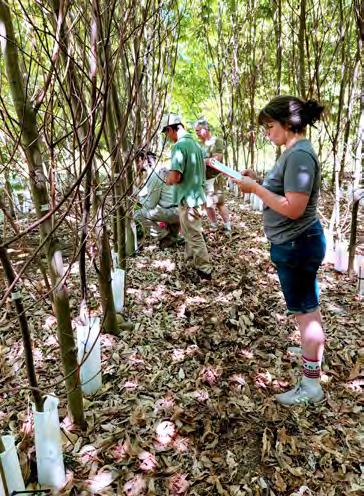

Long-time volunteer Don Surrette and Southern Regional Science Coordinator Jamie Van Clief discuss next steps at a planting at the Pryor Orchard in Edneyville, NC. Volunteers are a critical component in accomplishing the hard work of breeding, planting, and tending American chestnut trees.
guidance of their regional science coordinators (RSCs), have fed a significant quantity of data into a predictive model developed by Westbrook. In addition to blight resistance, chapter data regarding Phytophthora root rot (PRR) resistance has also been included in the effort, providing a more robust assessment of every potential breeding candidate. As a result of this careful assessment, we have found that while more limited in the breeding population than originally theorized, there are still many trees with improved disease resistance that can be utilized for further regionalized breeding. TACF’s state chapters have played a critical role in this effort, significantly expanding the geographic range and reach of our breeding program.
Partnership for Success
As outlined in “Optimizing Disease Resistance in American Chestnuts” (pg. 27), priority best x best crossing recommendations have been developed for each TACF region, with the hope for completion over the next three to five years. The next step for state chapter programs is to start utilizing these recommendations to:
• Evaluate the accessibility and breeding potential of the identified “best” trees
• Collect and process pollen for freezing and future use
• Perform controlled pollinations using recommended trees
• Harvest recommended crosses
• Sow harvested seeds in available greenhouse space and collect leaf tissue for further genotyping
• Identify the highest-performing trees with the assistance of TACF’s science staff
• Find and establish priority planting sites for selected offspring
Careful field data collection is an important component of the assessments TACF science staff and citizen scientists make towards determining which trees are good candidates for the best x best breeding program.
The Journal of The American Chestnut Foundation ~ 25 RSC COLUMN
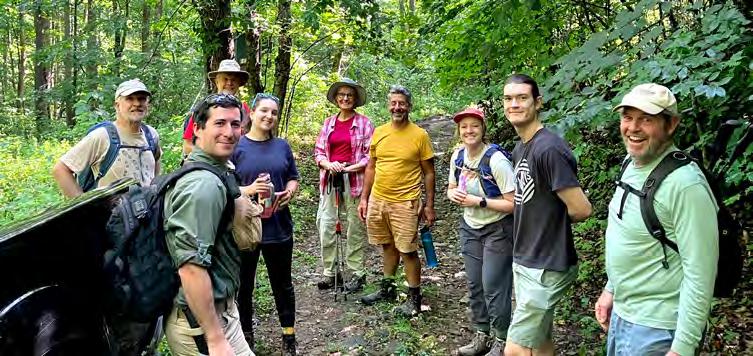
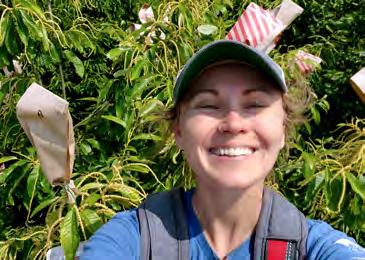
In addition, careful tracking using dentataBase (TACF’s online database) will be necessary to ensure priority trees are used appropriately, and the best crosses possible are made. This is going to be a significant undertaking and the RSCs will work closely with the chapters they serve, as well
as Westbrook and TACF’s scientific leadership, to ensure chapter programs are getting the information and support they need to be successful.
This renewed and expanded effort toward chapter breeding will also require increased engagement from volunteers. Learning, or brushing up on, controlled pollination and pollen collection skills will be a critical focus. Orchard and other research planting needs will also increase, providing more opportunities for chapters to engage public and private landowners in our work.
While the RSCs have been working for a few years now to offer more pollination training for volunteers, the addition of two regional outreach coordinators (ROCs) within the past year will also benefit the chapters in this effort. The ROCs have tackled many foundational projects to better support and strengthen state chapters, including providing insurance recommendations and developing a volunteer waiver, as well as tackling volunteer tracking and recruitment. ROCs have also worked to get to know their chapters and help them organize more events, which in turn has bolstered chapter engagement and provides a larger base to lean on for this expanded breeding work. As our chapters gear up for a busy field season, the regional team of RSCs and ROCs is preparing to do all we can to guide and support their efforts. Through this partnership between TACF staff, chapter leaders, and volunteer citizen scientists, we will tackle best x best breeding with renewed focus and hope for the future.
Mid-Atlantic Regional Science Coordinator Cassie Stark worked closely with the VA Chapter to make initial best x best crosses at Lesesne State Forest, an effort that will continue over the next few years.
Participants and staff hike in the Yellow Mountain Preserve to observe and discuss the silviculture and ecology of the 10-year-old American chestnut forest plantings, which have paved the way for future forest plantings of best x best material. Not pictured, Southern Regional Science Coordinator
26 ~ tacf.org RSC COLUMN
Jamie Van Clief and Park Greer of Southern Appalachian Highlands Conservancy.
Optimizing Disease Resistance
IN AMERICAN CHESTNUTS USING ADVANCED GENOMIC MODELING AND SELECTION
By Jared Westbrook, Director of Science
Crossing American chestnuts with Asiatic chestnuts has and will continue to be a strategy The American Chestnut Foundation (TACF) uses to generate populations with improved disease resistance. Large gains in both blight and Phytophthora root rot resistance are possible with optimized breeding and selection. While work continues on biotech solutions to improve disease resistance, there are several good reasons to also continue pursuing optimized breeding approaches (see box on next page).
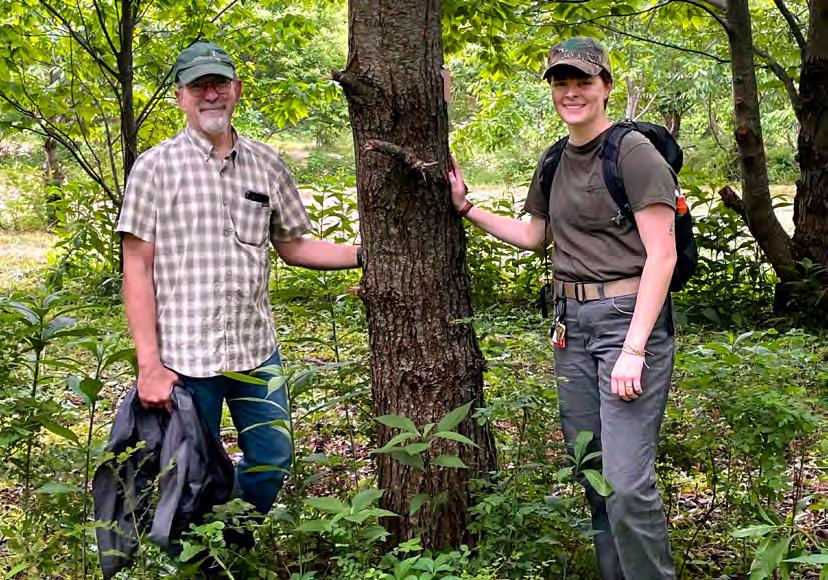
The Journal of The American Chestnut Foundation ~ 27 THE SCIENCE
VA Chapter President John Scrivani and Duke Stanback Intern Caraugh Heverly stand by a selected American chestnut hybrid with intermediate blight resistance.
WHY WE ARE CONTINUING WITH THE HYBRID BREEDING PROGRAM
Traditional breeding is not regulated. All can participate.
Pending improved performance, we would like to offer both traditionally bred and genetically engineered trees for multiple stakeholders.
Hybrids are currently the only source of Phytophthora root rot resistance.
Large gains in blight and Phytophthora root rot resistance are possible through optimizing breeding and selection.
The hybrid program represents genetic diversity from the wild-type American chestnut population that will be useful for climate resilience.
The backcross breeding program of TACF was historically based on a hypothesis that resistance to chestnut blight was controlled by a few large effect genes from Chinese chestnut. We now know that blight resistance is genetically complex, controlled by hundreds of genes on all 12 chromosomes contributed by the Chinese parent. This means that the expectations from outcomes of the backcross breeding program need to be reset and recalculated. The relevant questions to this reformation are:
How much blight resistance is sufficient for long-term success of these new populations?
What is the minimum amount of American chestnut ancestry that maximizes both competitiveness in the forest and ecosystem services?
We also need to select for improved resistance to Phytophthora root rot (PRR). This lethal disease is becoming more prevalent as the climate warms, especially in the southeast.
As originally outlined in TACF’s 3BUR strategy since 2015, and as we have discussed in Chestnut Chats since September 2023, restoration is not a singular endpoint and does not start with a singular “perfect” outcome. In order to realize restoration of this important species, multiple deployments will need to be made across the coming decades to realize ultimate success. Each of these deployments will unify tree varieties from a multitude of methods, and each will deliver added benefit to those that came before them. TACF will begin to provide the resultant trees of these best x best crosses to long-time, sponsor, and research supporters as soon as they can be established with our nursery partners, likely starting within the next year.
Setting standards for advanced genomic selections
For the first generation of best x best crosses of advanced genomic selections (AGS), I set a target of generating progeny with a minimum of 70% American chestnut ancestry and blight resistance greater than 40 on a 0 to 100 scale, where 0 is the average American chestnut resistance and 100 is the average Chinese chestnut resistance. These
targets represent 16.5% of trees in our extant breeding populations. Intermediate blight resistance, i.e. 40 – 80 on the blight resistance scale, may be sufficient for long-term survival. Measuring an average of 50 on the blight resistance scale, we have long observed Chinese x American F1 (50/50) hybrids surviving decades, despite long-term infection with chestnut blight. I also set a goal of selecting hybrids with a minimum resistance to PRR of 25. There will likely be a need for one additional generation of selection to further improve blight and PRR resistance to ensure long-term survival and establish a solid foundation upon which additional
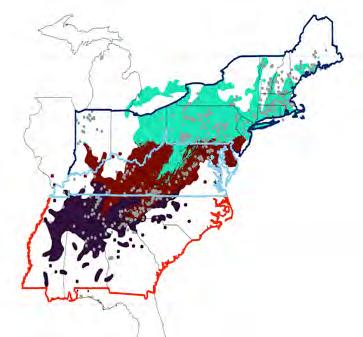
Regionalization into southern (dark blue), central (maroon), and northern (turquoise) breeding programs from Sandercock et al. 2023. The locations of wild American chestnuts that were used as parents in the hybrid breeding program or conserved in orchards are mapped as gray dots.
28 ~ A Benefit to Members THE SCIENCE
Figure 1
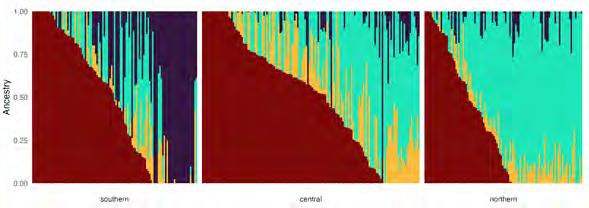

Regional American chestnut ancestry of TACF breeding stock as assessed from genotypes at 8,500 climate associated markers from Sandercock et al. 2023. These trees contain ancestry from central (maroon), southern (dark blue), northern (turquoise) regions as well as Chinese chestnut (yellow).
outcomes, such as OxO-containing transgenic trees, or those with gene-silencing technology, can be added.
In the second generation, we will increase the minimum selection threshold for blight resistance to 50 and PRR resistance to 40 while maintaining the minimum American chestnut ancestry at 70%. First-generation selections will be planted together in seed orchards so that it will be feasible to generate second generation progeny with open and controlled pollination. There may be additional need for selection for competitive growth form; however, if the trees have enough disease resistance for long-term survival, natural selection for competitiveness may be done in forest settings. Male sterility has arisen in some progeny due to incompatibilities between genes inherited from Chinese chestnut and mitochondria inherited from American chestnut (Sisco et al. 2014). We ultimately want these trees to reproduce on their own, so male sterility is an undesirable trait. The genetic variants that cause male sterility have recently been genetically mapped to a single location at the end of chromosome 3 (Fan et al. 2024). Selection for American chestnut ancestry at this genome location should produce AGS and progeny of AGS which are male fertile.
Regionalization
It is important to represent the genetic diversity from the wild American chestnut population in deployed populations so that they have potential to adapt to climate change and a large native range. I divided TACF’s program into three regions to approximate the geographic extent of three genetically distinct subpopulations of American chestnut (Sandercock et al. 2022; Sandercock et al. 2023) (Figure 1). The goals with regionalization are to collaborate across chapters to intercross AGS so that they surpass minimum standards and represent adaptive genetic diversity from the
FIRST GENERATION
• Three regions
• 60+ controlled pollinations
• 6,000+ progeny per region
Genomically select progeny with:
• Blight resistance > 40
• Phytophthora root rot resistance > 25
• American chestnut ancestry > 70%
• Male fertility
SECOND GENERATION
• Three regions
• > 1 seed orchard per region
• 60+ controlled pollinations
• 6,000+ progeny per region
Genomically select progeny with:
• Blight resistance > 40
• Phytophthora root rot resistance > 40
• American chestnut ancestry > 70%
Standards for the hybrid breeding program over two generations of best x best crosses and genomic selection.
three subpopulations of American chestnut. We performed whole genome sequencing on a subset of 371 hybrids from all three regions and confirmed that hybrid populations inherited genetic variants for climate adaptation from all three subpopulations of wild American chestnuts (Figure 2).
Figure 2
Figure 3
The Journal of The American Chestnut Foundation ~ 29 THE SCIENCE
Selecting parental cross combinations
Controlled pollinations between parents from each region will be necessary to generate progeny that meet standards for disease resistance and American chestnut ancestry. To screen and create a population of AGS for blight resistance, TACF staff and volunteers assessed the long-term blight resistance of 5,530 advanced backcrosses planted at more than 100 orchard locations. Blight resistance was estimated from an index of nine traits related to canker severity on stems and canopy health after adjusting for the effects of tree age, inoculation status, climate, and soil variables. To assess molecular ancestry of these trees, TACF partnered with the Holliday lab at Virginia Tech to genotype them. To assess PRR resistance, we partnered with the U.S. Forest Service and Clemson University to assess survival of progeny after inoculation with Phytophthora cinnamomi. Based on these data, I selected 414, 1,830, and 2,112 potential crosses from the south, central, and

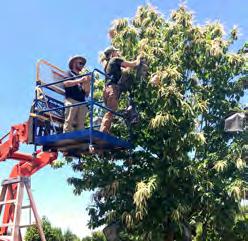
northern regions, respectively, where the average resistance and ancestry average of the two parents exceeded first generation standards. To minimize the potential deleterious effects of inbreeding, I excluded crosses where the two parents shared more than 12.5% of their genome, which is equivalent to the average relatedness of first cousins. TACF staff and volunteers have begun collecting and freezing pollen from potential parent trees so that pollen from trees at different locations is available when female parents are flowering. I recommend that each region performs at least 60 controlled pollinations over the next three to five years with an overall goal of generating more than 6,000 seed per region for further selection.
Genomic selection of progeny
After performing best x best crosses, we will use genomic prediction to select progeny that exceed our minimum standards (Figure 3). Genomic selection enables simultaneous prediction of blight and PRR resistance
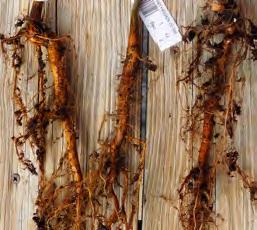

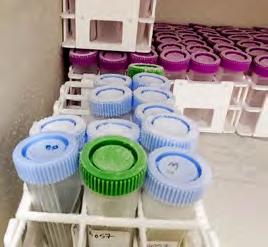
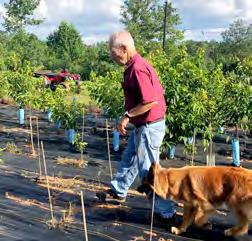
B E A D C WORKFLOW
OPTIMIZED BREEDING
SELECTION
Quantify blight resistance, PRR resistance,
Collect
freeze
selected
available
breeding.
parental
average, meet disease resistance
American
standards.
select
meet standards.
selected
seed
THE SCIENCE 30 ~ tacf.org
Figure 4
FOR
AND
: A
and American chestnut ancestry in the parental generation. B
and
pollen from the
parents so it is
when needed for
C Conduct controlled pollinations between
combinations that, on
and
chestnut ancestry
D Genotype and
progeny that
E Plant
progeny in
orchards.
without having to inoculate seedlings. Furthermore, we will genomically select seedlings that are male fertile and exceed American chestnut ancestry thresholds. Selected seedlings will be planted at wide spacing to minimize competition between trees. I developed genomic prediction models for blight and PRR resistance by way of assessing the relationships between genotypes and disease resistance in the parental generation. TACF is partnering with a company called Diversity Arrays Technology (DArT) for high-throughput and costeffective genotyping. We will pilot genomic selection on ~2,000 seedlings in 2024 and plan to scale up to genotyping 3,000 to 6,000 seedlings per year in subsequent years.
What to expect Figure 4 outlines a workflow for optimized breeding and selection. To determine if this workflow will meet our standards (Figure 3), I conducted simulations to predict gains in disease resistance and American chestnut ancestry over two generations of breeding and genomic selection for the southern region. Results from other regions are expected to be similar. For the first generation, I selected 60 crosses that exceeded minimum standards. Each parent was included in a maximum of three crosses. I simulated genotypes for 100 progeny per cross to obtain a total of 6,000 progeny. From the simulated genotypes, I selected 455 first-generation progeny (7.6% of 6,000 total) that were predicted to be male fertile and to exceed standards for disease resistance and ancestry (Figure 1). Blight resistance of first-generation selections was predicted to vary from 40 to 57 (average 45), PRR resistance from 25 to 55 (average 34), and
LITERATURE CITED
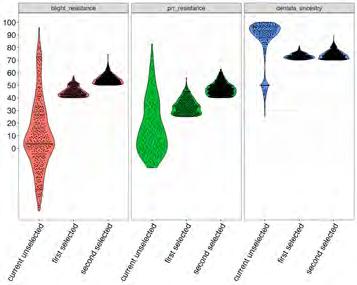
Simulations to predict gains in blight resistance, PRR resistance, and American chestnut ancestry over two generations of best x best crosses and genomic selection.
American chestnut ancestry from 70% to 81% (average 73%) (Figure 5). I then simulated two scenarios for the second generation: 1) First-generation selections were randomly crossed to generate 6,000 progeny, simulating open pollination. 2) Controlled pollinations were performed between first-generation selections, where the average of the two parents exceeded 50 for blight resistance, 40 for PRR resistance, and 70% for American chestnut ancestry to generate 6,000 progeny from 60 crosses. For the open pollination scenario, I obtained only 129 progeny (2.2% of total) that surpassed second generation standards (Figure 3), too few to plant a seed orchard. By contrast, in the controlled pollination scenario, I obtained more selections (1,111 selections or 18.5% of the total) that exceeded standards. Secondgeneration selections from controlled pollination were predicted to have blight resistance that varied from 50 to 75 (average 55), PRR resistance that varied from 40 to 63 (average 47.4), and American chestnut ancestry that varied from 70% to 89% (average 74%) (Figure 5). I conclude from the simulations that controlled pollination and genomic selection are necessary steps to get the desired gains in blight and PRR resistance without increasing Chinese chestnut ancestry. If we take these steps, I am optimistic that this breeding program comprised of Advanced Genomic Selections (AGS) will produce trees with sufficient disease resistance and competitive ability for long-term survival and reproduction in the forest and also provide a reliable foundation for layering of additional outcomes from other scientific pursuits of TACF.
Fan S, Georgi LL, Hebard FV, Zhebentyayeva T, Yu J, Sisco PH, Fitzsimmons SF, Staton ME, Abbott AG, Nelson CD. 2024. Mapping QTLs for blight resistance and morphological traits in inter-species hybrid families of chestnut (Castanea spp.). Frontiers in Plant Science (accepted, Feb 2024).
Sisco PH, Neel TC, Hebard FC, Craddock JH, Shaw J. 2014. Cytoplasmic male sterility in interspecific hybrids between American and Asian Castanea species is correlated with the American D chloroplast haplotype. Acta Horticulturae doi: 10.17660/ActaHortic.2014.1019.32.
Sandercock AM, Westbrook JW, Zhang Q, Johnson HA, Saielli TM, Scrivani JA, Fitzsimmons SF, Collins K, Perkins MT, Craddock JH, Schmutz J, Grimwood J, Holliday JA. 2022. Frozen in time: Rangewide genomic diversity, structure, and demographic history of relict American chestnut populations. Molecular Ecology (18): 4640-4655. doi: 10.1111/mec.16629.
Sandercock AM, Westbrook JW, Zhang Q, Holliday JA. 2023. The road to restoration: Identifying and conserving the adaptive legacy of American chestnut. bioRxiv. doi: https://doi.org/10.1101/2023.05.30.542850.
THE SCIENCE The Journal of The American Chestnut Foundation ~ 31
Figure 5
The Chestnut Blight Fungus
By Mark Double, WV-TACF Chapter
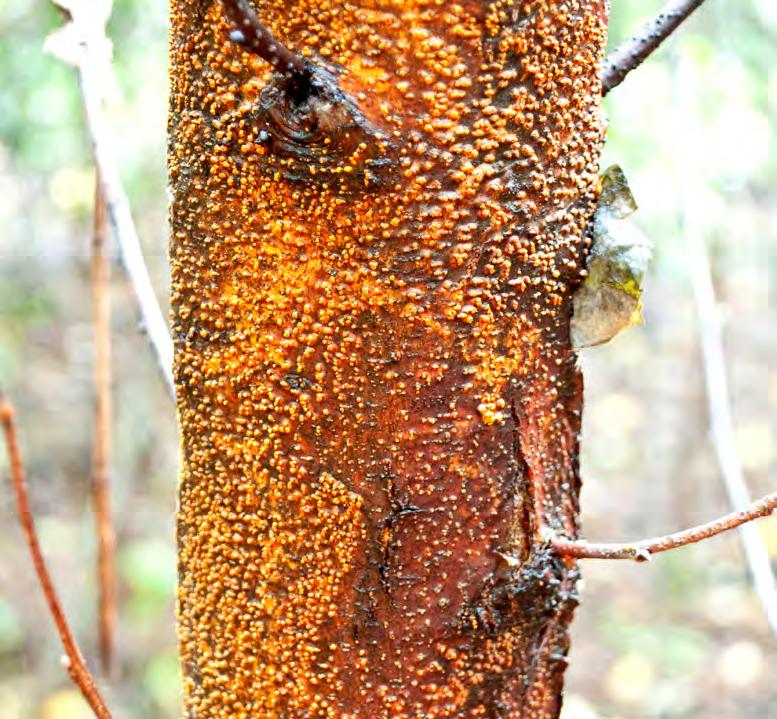 Orange-pigmented fungus on an American chestnut stem. All photos by Mark Double, except 1906 historical photo.
Orange-pigmented fungus on an American chestnut stem. All photos by Mark Double, except 1906 historical photo.
THE SCIENCE 32 ~ A Benefit to Members
Figure 1
Restoration of American chestnut is necessary due to the actions of a fungus that was imported accidentally into the U.S. on infected Japanese chestnut. In 1904, Hermann Merkel, chief forester for the Bronx Zoo in New York City, noticed brown leaves in mid-summer on the majestic American chestnuts lining the zoo’s walkways. Merkel wrote that a few scattered cases occurred [on American chestnut trees] during the summer of 1904. Early in June 1905, this disease was noticed on so many widely scattered trees of all sizes that specimen branches and an appeal for information were sent to the USDA (Merkel, 1905).
In 1906, William Murrill (assistant curator of the New York Botanical Garden) wrote, “A new and very serious disease of our native chestnut is epidemic in many parts of New York City and threatens to destroy practically all the chestnut trees in this vicinity. An investigation of the disease was begun in the New York Botanical Garden nearly a year ago, and most of the facts regarding it are now in our possession. The fungus in question appears to be confined to our native chestnut. I have shown specimens to many mycologists, both in Europe and America, and they all pronounce it new to them and undescribed. It belongs to Diaporthe, a large genus whose species are, as a rule, confined to dead wood and are


not parasitic. The name I have chosen refers to its very destructive parasitic habit. I have named the fungus Diaporthe parasitica” (Murrill, 1906).
After the blight fungus was discovered in New York City, plant explorer Frank Meyer found that it was present in both China and Japan, and that Asian trees were often very resistant to the disease and showed few symptoms when infected (Shear and Stevens, 1913). This was taken as proof that Asian trees imported into the United States had brought the blight with them (Anagnostakis, 1997).
There were several documented importations of Japanese chestnut trees (Castanea crenata) into the U.S. between 1876 and 1882. Any of several importations of Japanese chestnut trees could have been the source of chestnut blight. In addition, the mail-order sales could have spread imported blight to all
 Orange-pigmented Cryphonectria parasitica on agar in a Petri dish.
A close-up of the orange pustules (stroma) on an American chestnut canker. The black dots are the necks of the perithecia shown in Figure 5.
Figure 2
Figure 3
Orange-pigmented Cryphonectria parasitica on agar in a Petri dish.
A close-up of the orange pustules (stroma) on an American chestnut canker. The black dots are the necks of the perithecia shown in Figure 5.
Figure 2
Figure 3
THE SCIENCE The Journal of The American Chestnut Foundation ~ 33 The Journal of The American Chestnut Foundation ~
American chestnut trees at the New York Botanical Garden in 1906.
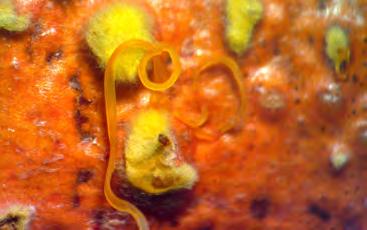
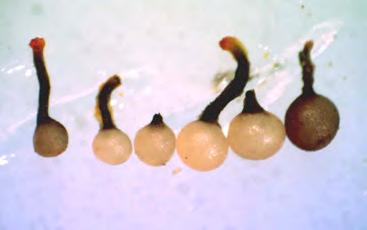
perithecia in which the sexual spores are produced. The black necks grow through to the top of the stroma where the asci are released. These structures were teased from the stroma with a dissecting needle and placed on agar for the photograph.
the locations where the trees were shipped (Anagnostakis, 1997).
As per Murrill’s taxonomic description in 1906, the causal agent of chestnut blight was known as Diaporthe parasitica. In 1912, the name was changed to Endothia parasitica (Shear and Stevens, 1917). The name was changed again in 1978 by mycologist, Margaret Barr, who placed the fungus in the genus Cryphonectria. If no further changes are necessary, the fungus continues as Cryphonectria parasitica
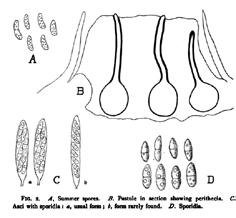
It is reported that 4 billion trees were lost to the fungus over the course of 50 years. The fungus co-evolved with Asian chestnut species over millennia, but found two chestnut relatives, European (Castanea sativa) and American chestnut (Castanea dentata), that have littleto-no resistance to the fungus.
The spread of the chestnut blight fungus over the range of American chestnut was aided by two spore types, asexual and sexual. Both spore types form cankers on chestnut trees.
The fungus is distinctly orangepigmented, whether as a canker on a tree (Figure 1, pg. 32) or as a culture on a Petri dish (Figure 2, previous page). Both spore types are formed in the orange pustules on cankers, known scientifically as stroma (Figure 3, previous page). The asexual spores (conidia) are thought to be the spore type for localized spread. These spores are produced in the stroma and exuded in a sticky matrix (cirrhi) that often resemble pig tails. Cirrhi are produced in conditions of high moisture and the tens of thousands
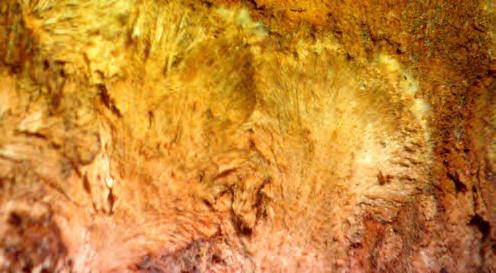 Asexual spores are produced in sticky cirrhi.
Figure 4
Pear-shaped
Figure 5
Diagram from W.A. Murrill (1906) showing: (A) asexual conidia; (B) perithecia; (C) asci with eight two-celled ascospores; and (D) ascospores.
Figure 6
Fans of the fungus form in the vascular cambium of the tree.
Asexual spores are produced in sticky cirrhi.
Figure 4
Pear-shaped
Figure 5
Diagram from W.A. Murrill (1906) showing: (A) asexual conidia; (B) perithecia; (C) asci with eight two-celled ascospores; and (D) ascospores.
Figure 6
Fans of the fungus form in the vascular cambium of the tree.
THE SCIENCE 34 ~ tacf.org
Figure 7
of spores are washed over the tree during rain events (Figure 4). The asexual conidia often find cracks as they are washed over the bark and initiate new cankers.
The sexual spores (ascospores) also are produced in the stroma in pear-shaped structures referred to as perithecia. In Figure 5, there are several individual perithecia that were teased from the stroma. (Note the orange stroma on the top of the perithecia.) The chestnut blight fungus is classified as an Ascomycete. What makes Ascomycete unique is that the sexual spores are formed in fragile translucent sacs called asci. Each ascus has eight two-celled ascospores. Thousands of these packets of spores are “shot out” of the necks of the perithecia when weather conditions permit. The spores are non-motile,
but when shot out of the necks, the spore packets are picked up by the wind and disseminated over long distances. Diagrams of perithecia, asci, and the two spore types are shown in Figure 6. The conidia are smaller than the two-celled ascospores.
Whether a canker is initiated by an asexual or sexual spore, both sit in a crack in the bark until conditions allow for germination. Once a spore germinates, the threads of the fungus begin forming a fan (Figure 7). The fungus grows in the vascular cambium exuding organic acids in advance of the threads. The acids kill the tissues in this region, and the contents of the cells are utilized by the fungus. As the fungus grows around the circumference of a branch or main stem, everything distal to the infection is killed.
LITERATURE CITED
Anagnostakis, S.A. 1997. Chestnuts and the Introduction of Chestnut Blight. Connecticut Agricultural Experiment Station Fact Sheet. PP008. Merkel, Hermann W. 1905. A deadly fungus on the American chestnut. N.Y. Zoological Society, 10th Annual Report, pp. 97-103.
Murrill, William A. 1906, A New Chestnut Disease. Torreya 6:186-189.
Shear, C. L. and N. E. Stevens. 1913. The chestnutblight parasite (Endothia parasitica) from China. Science 38:295-297.
Shear, C. L. and N. E. Stevens. 1917. Endothia parasitica and related species. USDA Bulletin #308, 82 pp.
ABOUT THE AUTHOR
Mark Double worked on the chestnut blight fungus for 41 years at West Virginia University before retiring in 2019.
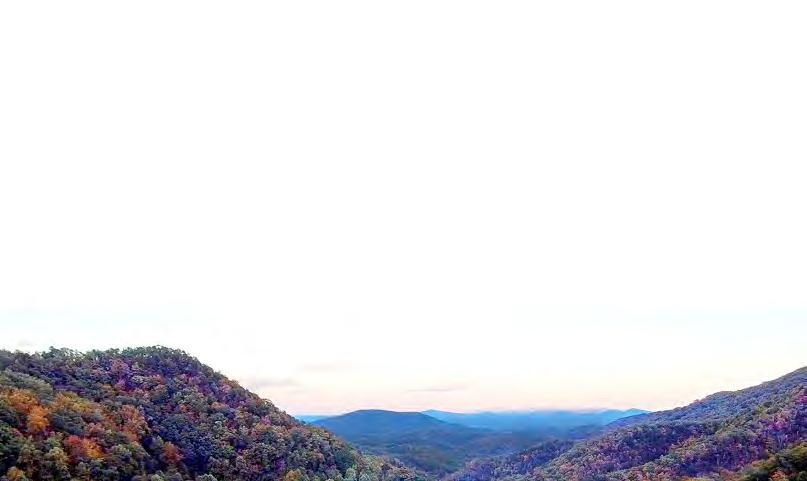

This film is a story about a tree that once graced the forests of Appalachia, nurtured communities, and held us from cradle to grave. It is a story about the people whose unwavering determination to save it has ignited a scientific path for restoration. It is a story about the promise of healthier forests for future generations who will inherit a brighter world because of its survival.
SAVE THE DATE: JUNE 22, 2024 FOR THE PUBLIC RELEASE OF THE AWARD-WINNING DOCUMENTARY Visit RescuingTheAmericanChestnut.com to view the trailer, screening schedules, and updates.
THE SCIENCE

Learning by Doing
By Ray Phillips, 2023 Summer Intern at Meadowview Research Farms
When you first arrive at the Glenn C. Price Research Farm, the vast, rolling hills in the background distract from all other scenery. Upon closer inspection, however, there are a variety of orchards and planting sites that host a diverse array of insects. I spent much of my internship researching the dynamics within these sites: how do these tiny organisms interact with each other? How do our actions influence that? Is there a better way to control the ever-present aphid population than pesticides alone?
Before this summer internship, I had almost zero experience with integrated pest management, despite its invaluable role in many backyard and botanical gardens. My training included a brief crash course, and after that, I was released to learn by doing, which generally involved scouring the shade houses for pests for hours on end. During my second week, the Meadowview staff went out to plant native plant borders on two sides of the shade house complex. These plantings were designed not just to improve morale, but also to draw in beneficial insects near the greenhouse: predators and parasitoids that patrol tirelessly in search of aphids, beetles, and other soft-bodied pests.
Drawing from the principles that inspired those plantings, I spent hours combing through online resources on conservation biocontrol, ecological mowing, and integrated pest management so I could create a fact sheet to help chestnut growers implement these strategies in their own orchards. You
36 ~ A Benefit to Members INTERN REFLECTIONS
Ray wearing a harness in the bucket lift during pollination season on the Wagner Farm at Meadowview.


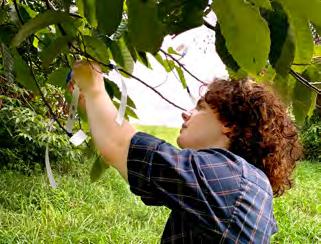
can find the factsheet on TACF’s website at bit.ly/factsheet-biocontrol. Outside of that research, I was able to spend a lot of quality time with some of the staff while helping with catkin bagging and pollination. I also had the opportunity to assist in field inoculations and prepare inocula: two skills that will serve me well in the many years of graduate school ahead. In addition to honing my research and laboratory skills, I spent much of the summer refining my cleaning and caretaking skills in the nursery. By the end of my first few weeks, I could assemble irrigation tubing in my sleep.
Without a doubt, I can say that the expectations I set for my time at Meadowview Research Farms were all exceeded. The staff here are not just dedicated, they are kind, knowledgeable, and incredibly competent, and I could not have asked for a better group of people to spend my summer with. Leaving is bittersweet, but I am looking forward to sharing everything I have learned about biocontrol and conservation with my peers, professors, and coworkers back in Georgia. In the meantime, I will be searching for the best places to hunt for chestnuts before harvest season hits, though the squirrels might beat me to them.
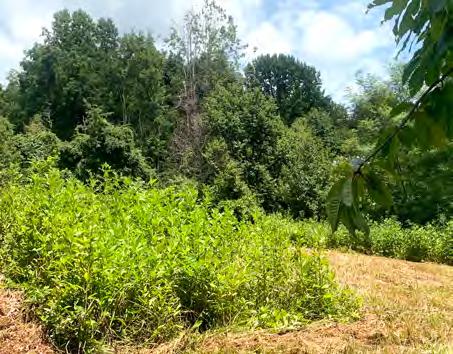 The pollinator patch planted next to shade houses at the Meadowview nursery.
An example of conservation mowing at the Lesesne State Forest chestnut orchards.
The pollinator patch planted next to shade houses at the Meadowview nursery.
An example of conservation mowing at the Lesesne State Forest chestnut orchards.
The Journal of The American Chestnut Foundation ~ 37 INTERN REFLECTIONS
Conservation mowing reduces the amount of time you spend mowing and also provides valuable habitat for insects.
Chestnut Smoothie
By Shaomin Li, Controller
When TACF employee Shaomin Li told everyone in the national office that she used chestnuts from the tree in her yard to make a delicious smoothie, and then shared it with all of us, we knew we had to provide the recipe to all of you. Yum.


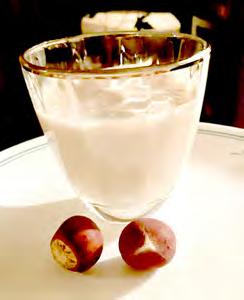
My family has a very old Chinese chestnut tree in our yard. Every year, we try to collect the chestnuts before the squirrels get to them. Last year, a deer family was ahead of us in getting to enjoy the chestnuts, but luckily, we were still able to collect some! A couple of years ago we were not sure what to do with all of the nuts, but decided to try them in a smoothie, and it turned out to be our favorite drink! As chestnut season approached last year, we could not wait to make the smoothies again. This is a very simple recipe with only three ingredients, and I feel honored to share it with you. Enjoy!
Ingredients
2 cups cooked, shelled, and peeled chestnuts
3 cups whole milk
3 Tbsp sugar
Instructions
Cut a cross through the chestnut shell, then steam chestnuts at low heat for two hours. Tip: steam the chestnuts above water to preserve their rich taste. Shell the chestnuts while they are hot, as it is much easier to peel the skin off at a warmer temperature.
Combine the cooked chestnuts, whole milk, and sugar in a blender.
Be sure the lid of the blender is tightly covered. Start at the lowest speed for 30 seconds, then switch to high speed for several minutes, or until the mixture looks very creamy and you can no longer see tiny particles of chestnut. Tip: turn the blender on and off several times so it does not become overheated.
38 ~ tacf.org RECIPE
Remembrances of William (Bill) Powell
By Mark Double, WV Chapter
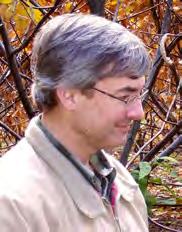
Members of The American Chestnut Foundation have read a lot about Darling 58, the genetically modified American chestnut tree, over the last few years. What many may not know is that the man behind the idea of using a gene from wheat to break down oxalic acid was Bill Powell from the State University of New York, College of Environmental Science and Forestry (SUNY-ESF). Sadly, Bill passed away on November 12, 2023, at the age of 67.
I first met Bill when he was a graduate student of Neal Van Alfen at Utah State University. In 1986, Bill completed the requirements for his Ph.D. with his dissertation, “Differential accumulation of Poly (A) + RNA and polypeptides between virulent and dsRNAinduced hypovirulent strains of Cryphonectria (Endothia) parasitica.” Following a stint at the University of Florida, Bill came to SUNY-ESF in 1989 and founded the American Chestnut Research and Restoration Project with his colleague Charles (Chuck) Maynard to contribute their research in biotechnology toward the restoration of this iconic tree species.
Bill became a core member of the USDA multistate project, NE-140, ‘Biological Improvement of Chestnut through Technologies that Address Management of the Species and its Pathogens and Pests.’ This group of 30-40 researchers and students met annually, and Bill attended faithfully.
While Bill was a skilled scientist and exacting in his work, he had a lighter side. I recall Bill and Paul Sisco, former regional science coordinator at TACF, flatfooting during some live Bluegrass music being played at the Cataloochee Ranch in Maggie Valley, NC in 2010. Bill had that wry smile as he danced.
The research group of Bill and Chuck was small at the beginning, but over the years, their group grew to include not only graduate and undergraduate students, but high school students and a very reliable staff. Theirs was a close-knit group. Bill was a passionate and affirming leader, and his interaction with his students and staff was very professional. Bill, always the mentor, had his students prepared exceptionally well before they gave a presentation.
Bill was also an excellent communicator. I think the culmination of his work as a researcher was his TEDxDeExtinction talk, “Reviving the American forests with the American chestnut” in 2013. Bill
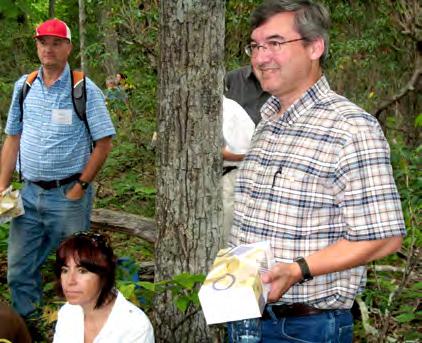
TRIBUTE The Journal of The American Chestnut Foundation ~ 39
Bill with fellow scientists at Hungry Mother State Park in Marion, VA, 2007.

commanded the stage, and he gave a very convincing national presentation. Bill was interviewed countless times, but one of the most impactful was an interview for the “Stories of Impact” series for Templeton World Charity Foundation. Bill provided a lengthy, yet concise story of his involvement with chestnut where he detailed his challenges and successes.
Bill spent more than three decades working toward American chestnut restoration. He was a dedicated scientist, mentor, and educator, remembered for his warm and generous spirit. He fostered an environment of teamwork and collaboration with many members of the chestnut community, and he was a friend to all.
The chestnut world lost a true giant.
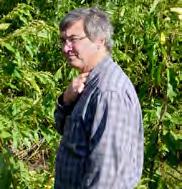
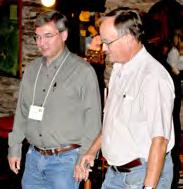
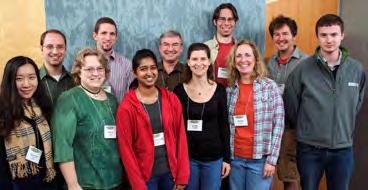
IN HONOR OF OUR TACF MEMBERS
JANUARY 10, 2024 – MARCH 31, 2024
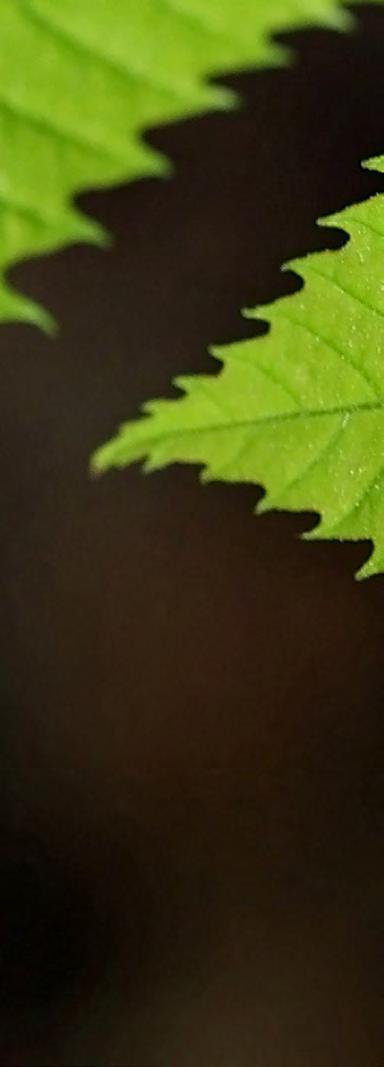
Anthony Carr-Mastrella From: Lynn Varricchio
Dr. Hill Craddock From: Ana Metaxas
Patty Dosher From:
Fern Piercing and Fine Jewelry
Jeremy Fishman From: Sara Philibotte
Peter Fry From: Allan McLane Chambliss Jr. DeForrest Hipps From: Pranam Ben
Keystone Resources From: Benjamin LeComte
Maxwell William Moll From: Robert H. Moll
JR Myers From: Amy Salins-Myers
Emily Rutherford From: Allison Bates
Emily and Kevin Kelly
Thomas Saielli From: David Jerry McMillin
Don Surrette From: Lane Herrlinger
Matt Tunney From: Thomas Tunney
Maxwell Turpin From: Devanney Haruta
Derek Zona From: Patrick Benavides
Bill among the chestnuts at the USDA multistate research meeting in Hamilton, NY, 2005.
Bill (back row, center) with his lab group during the NE-1833 meeting at SUNY-ESF in Syracuse, NY, 2016.
Bill (left) and Paul Sisco flatfooting.
40 ~ A Benefit to Members TRIBUTE
Chuck Maynard and Bill (right) at SUNY-ESF’s greenhouse.
IN MEMORY OF OUR TACF MEMBERS
JANUARY 10, 2024 – MARCH 31, 2024
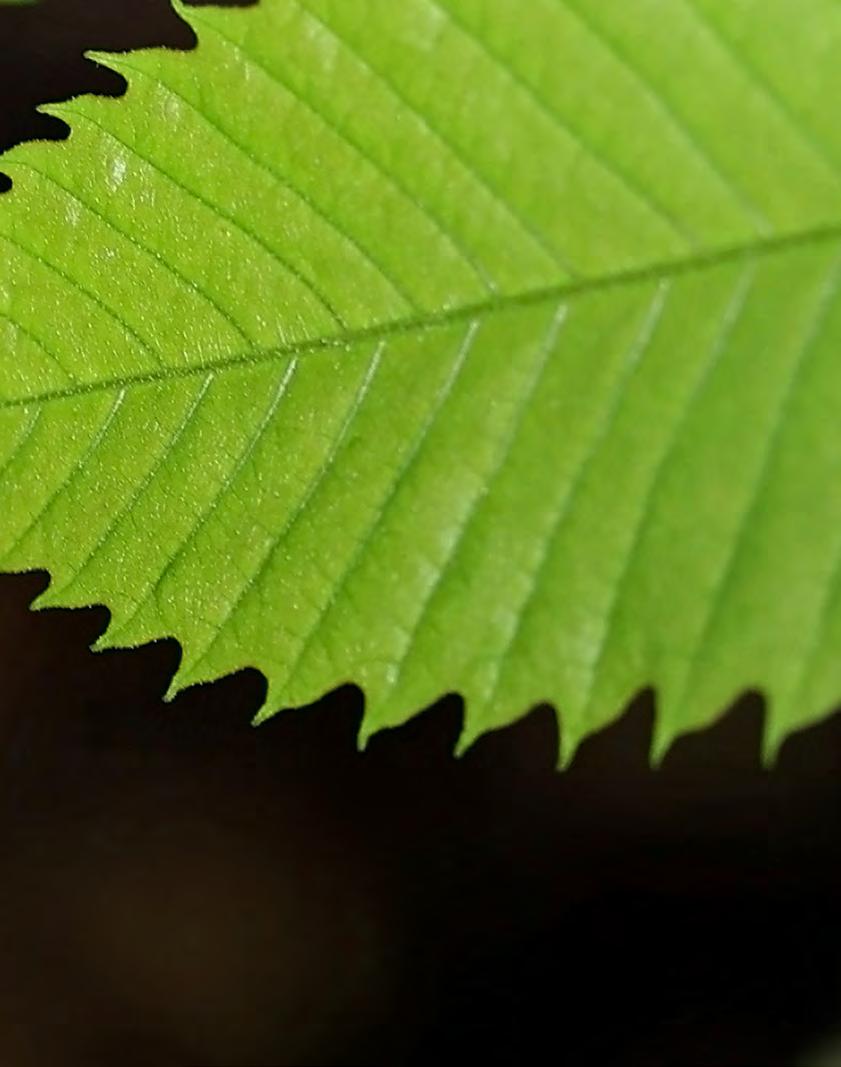
Carl Absher From:
Jon Eric Claunch
Peter B. McChesney
Howland “Bud” Adams, Jr. From: Margaret Charpentier
Louise Van Bokkelen From:
James and Jocelyn Van Bokkelen
James Ely Bradfield From:
John G. and Amy Bradfield
Dr. Charles Burnham From:
Dr. Paul and Christine E. Read
Rosalynn Carter From:
Betty and John A. Allison
Fredric L. Cheyette From:
Catherine and Oren Cheyette
Jon Michael Cude From:
Betty and John A. Allison
Dr. Deborah J. Delmer
Dr. Kim and Susan Steiner
Barbara M. Tormoehlen
Myra Anne Gesse Dean From: Rebecca Henson
William Atwood DeCoster From: Daisy DeCoster
Nelson Downing From: Dale Higdon
Dr. John E. Elliston From: Ronald Willey
Jesse T. Hale, Jr From: Denise and Jim Blakeney
Bruce Hansen From: Danya Miller
Vincent Hatton From:
Anne L. Hatton
Scot Hudson From: Dewitt Roper
Kenneth H. Klipstein From: Ernest Christian Klipstein
Kenneth S. Lay From:
Kenneth G. Lay
Gary Lindemann From: Patricia Alexander
Lydia McMeanscharl and William Carson From: Charles Hardy
We regret any errors or omissions and hope you will bring them to our attention.
Frederick Brandon Meyer From: Richard Winn
Richard “Dick” Norrie From: Jessica Riolo
M. Deborah Nye-Corgan From: Gail Pellegatto
Joseph A Pantalone From: Valerie Pantalone
Stuart Peppard From: Stephen Peppard
Richard (Bud) Stanley From:
Becky Spritz
Dan Vlastelica From: Nanette Abert
Mike Wrublewski From: Peter Wrublewski
Andris Zoltners From: Greggor Zoltners
IN HONOR AND IN MEMORY The Journal of The American Chestnut Foundation ~ 41

Innovations
ACCELERATED THROUGH YOUR SUPPORT
Staff and other collaborators are performing field and lab testing on the best-performing trees in our orchards to develop enhanced disease resistance. For ongoing genetic gain and improvement, we must develop essential in-house laboratory capabilities that optimize modern molecular and modeling methods. Through your donations, TACF’s scientific collaborations will be strengthened, our ability to monitor parallel efforts will increase, and the most disease-resistant and ecologically sound American chestnut trees will be available for long-term service to our forests.
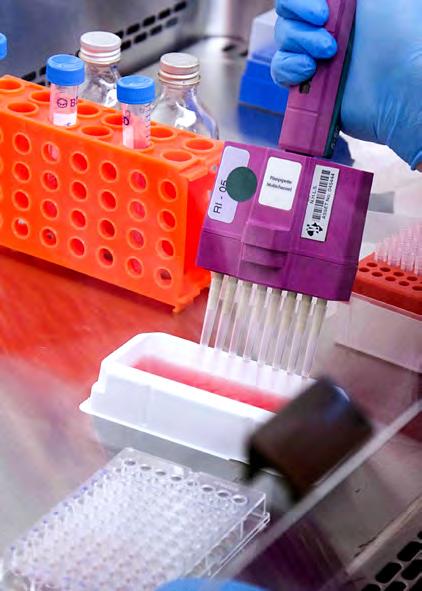
50 N. Merrimon Avenue Suite 115 Asheville, NC 28804
CREATING THE VITAL BRIDGE BETWEEN SCIENCE AND NATURE
2024 SPRING APPEAL






 Will Pitt President & CEO
Will Pitt President & CEO

 Will Pitt, President & CEO The American Chestnut Foundation
Will Pitt, President & CEO The American Chestnut Foundation



 Jockey Hill Farm, surrounded by the Calvin Coolidge State Forest.
Jockey Hill Farm, surrounded by the Calvin Coolidge State Forest.




 One of 50 chestnuts planted in spring 2022.
Tim with his daughter Eliza and granddaughter Faye at Faye’s Chestnut Forest.
Family and friends at an annual tree planting weekend.
Tim’s daughter Alison and niece Emily planting climate-resilient trees.
One of 50 chestnuts planted in spring 2022.
Tim with his daughter Eliza and granddaughter Faye at Faye’s Chestnut Forest.
Family and friends at an annual tree planting weekend.
Tim’s daughter Alison and niece Emily planting climate-resilient trees.




























 Laura with her Girl Scout sash today. Those skills transferred well to caring for chestnuts.
Laura with her Girl Scout sash today. Those skills transferred well to caring for chestnuts.

































 Orange-pigmented fungus on an American chestnut stem. All photos by Mark Double, except 1906 historical photo.
Orange-pigmented fungus on an American chestnut stem. All photos by Mark Double, except 1906 historical photo.


 Orange-pigmented Cryphonectria parasitica on agar in a Petri dish.
A close-up of the orange pustules (stroma) on an American chestnut canker. The black dots are the necks of the perithecia shown in Figure 5.
Figure 2
Figure 3
Orange-pigmented Cryphonectria parasitica on agar in a Petri dish.
A close-up of the orange pustules (stroma) on an American chestnut canker. The black dots are the necks of the perithecia shown in Figure 5.
Figure 2
Figure 3



 Asexual spores are produced in sticky cirrhi.
Figure 4
Pear-shaped
Figure 5
Diagram from W.A. Murrill (1906) showing: (A) asexual conidia; (B) perithecia; (C) asci with eight two-celled ascospores; and (D) ascospores.
Figure 6
Fans of the fungus form in the vascular cambium of the tree.
Asexual spores are produced in sticky cirrhi.
Figure 4
Pear-shaped
Figure 5
Diagram from W.A. Murrill (1906) showing: (A) asexual conidia; (B) perithecia; (C) asci with eight two-celled ascospores; and (D) ascospores.
Figure 6
Fans of the fungus form in the vascular cambium of the tree.






 The pollinator patch planted next to shade houses at the Meadowview nursery.
An example of conservation mowing at the Lesesne State Forest chestnut orchards.
The pollinator patch planted next to shade houses at the Meadowview nursery.
An example of conservation mowing at the Lesesne State Forest chestnut orchards.











